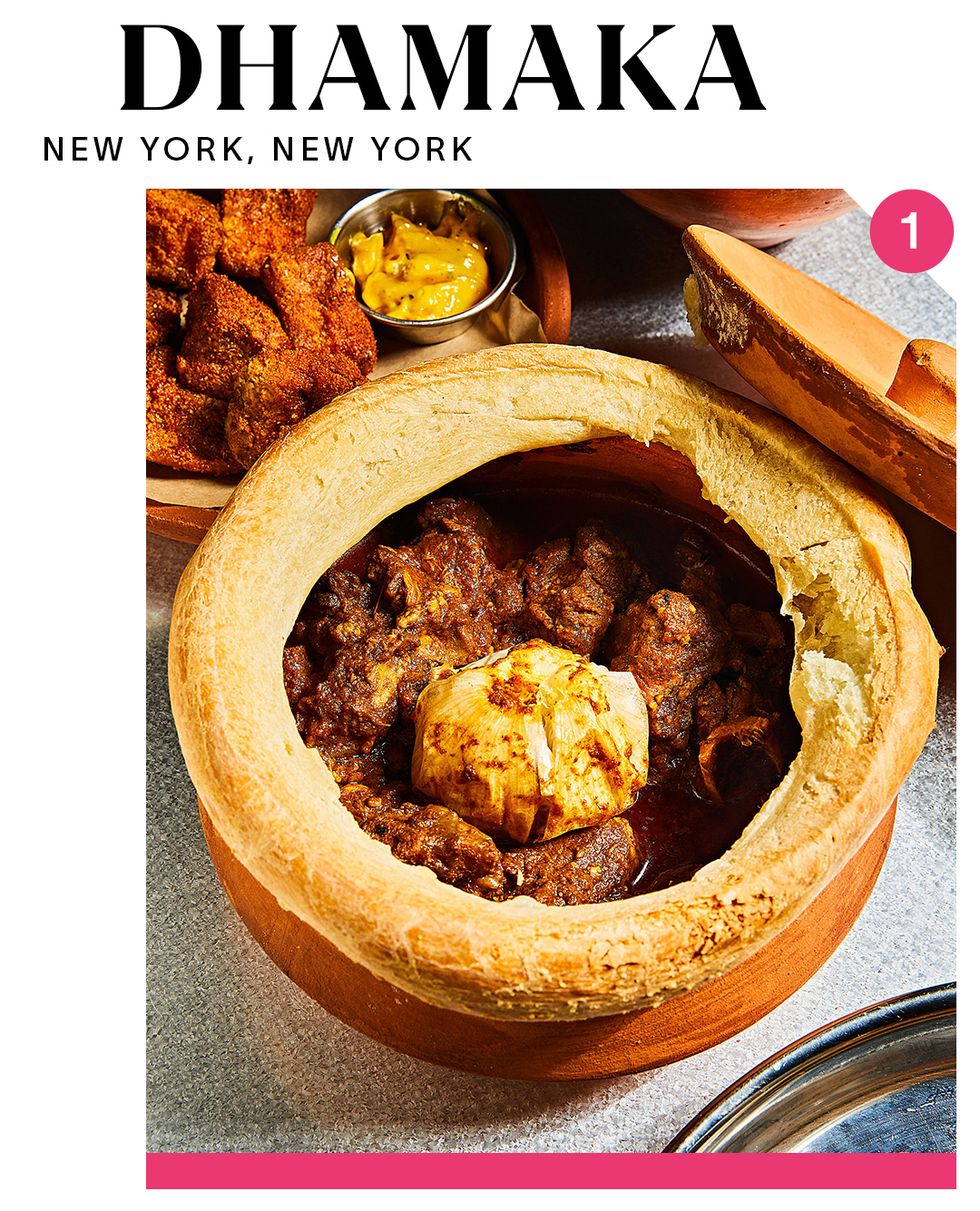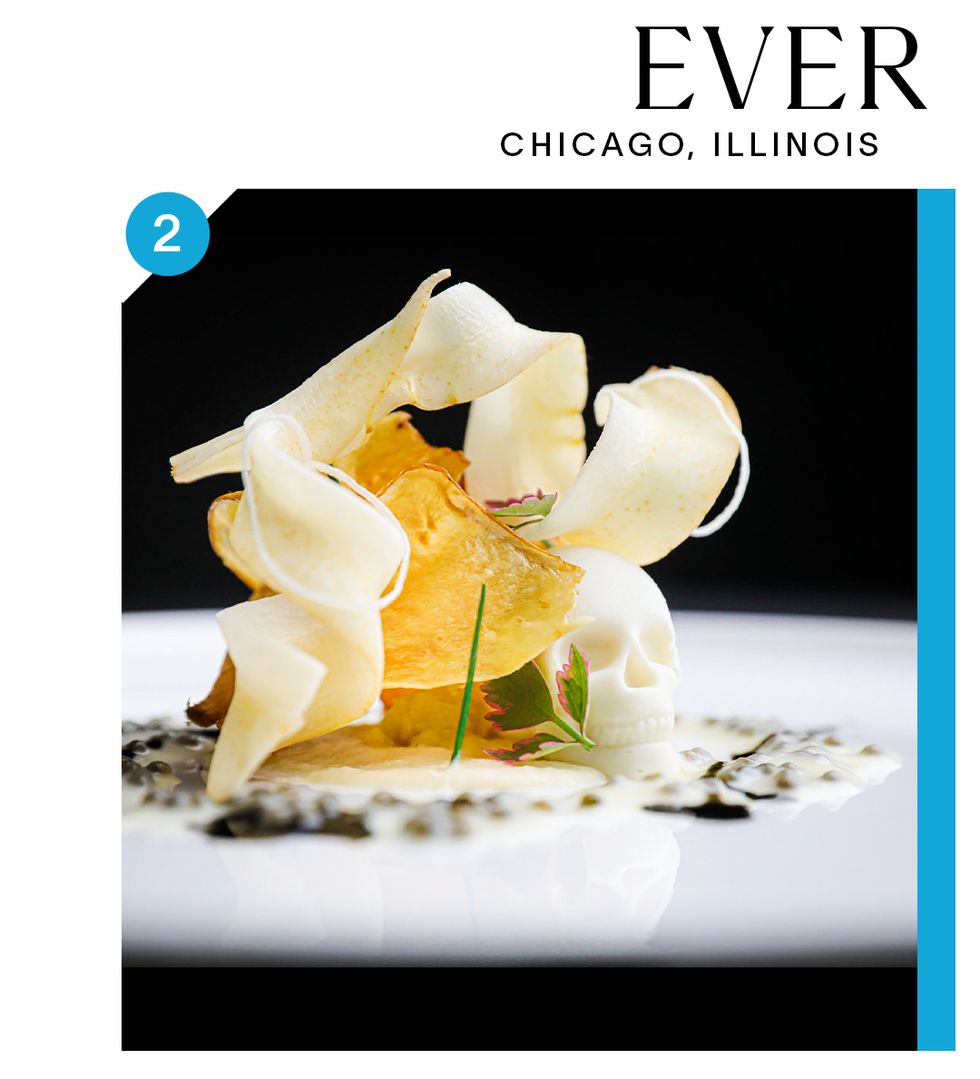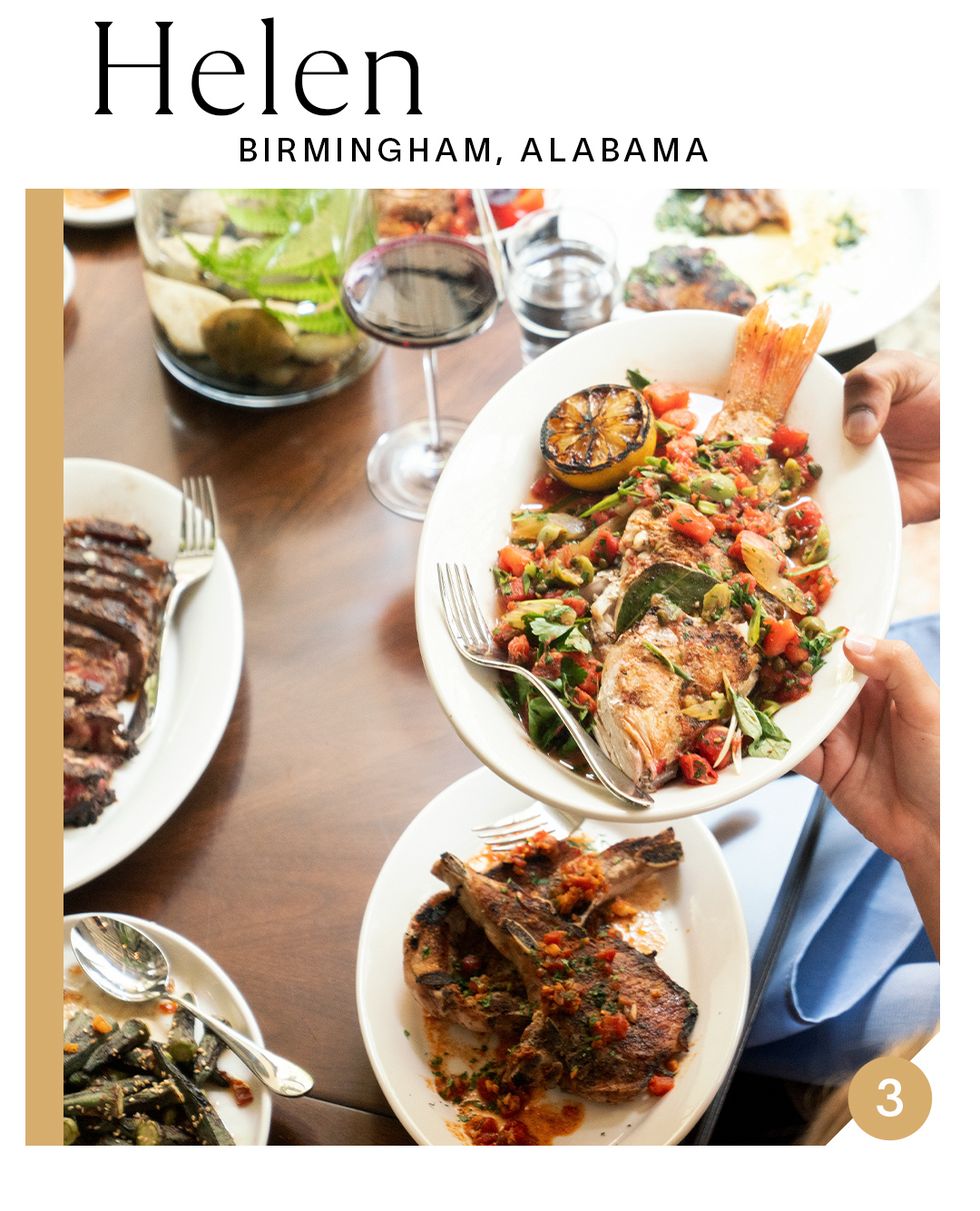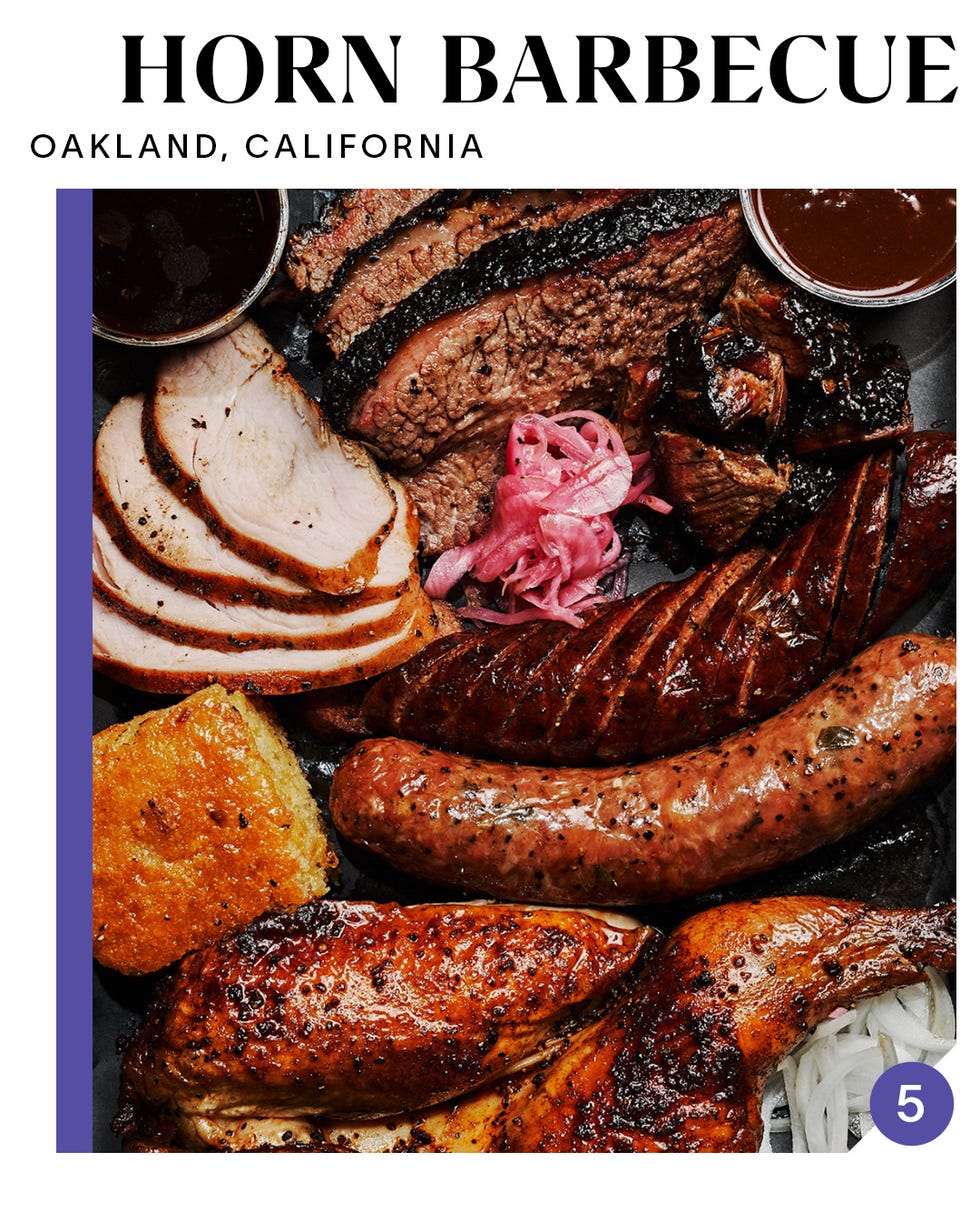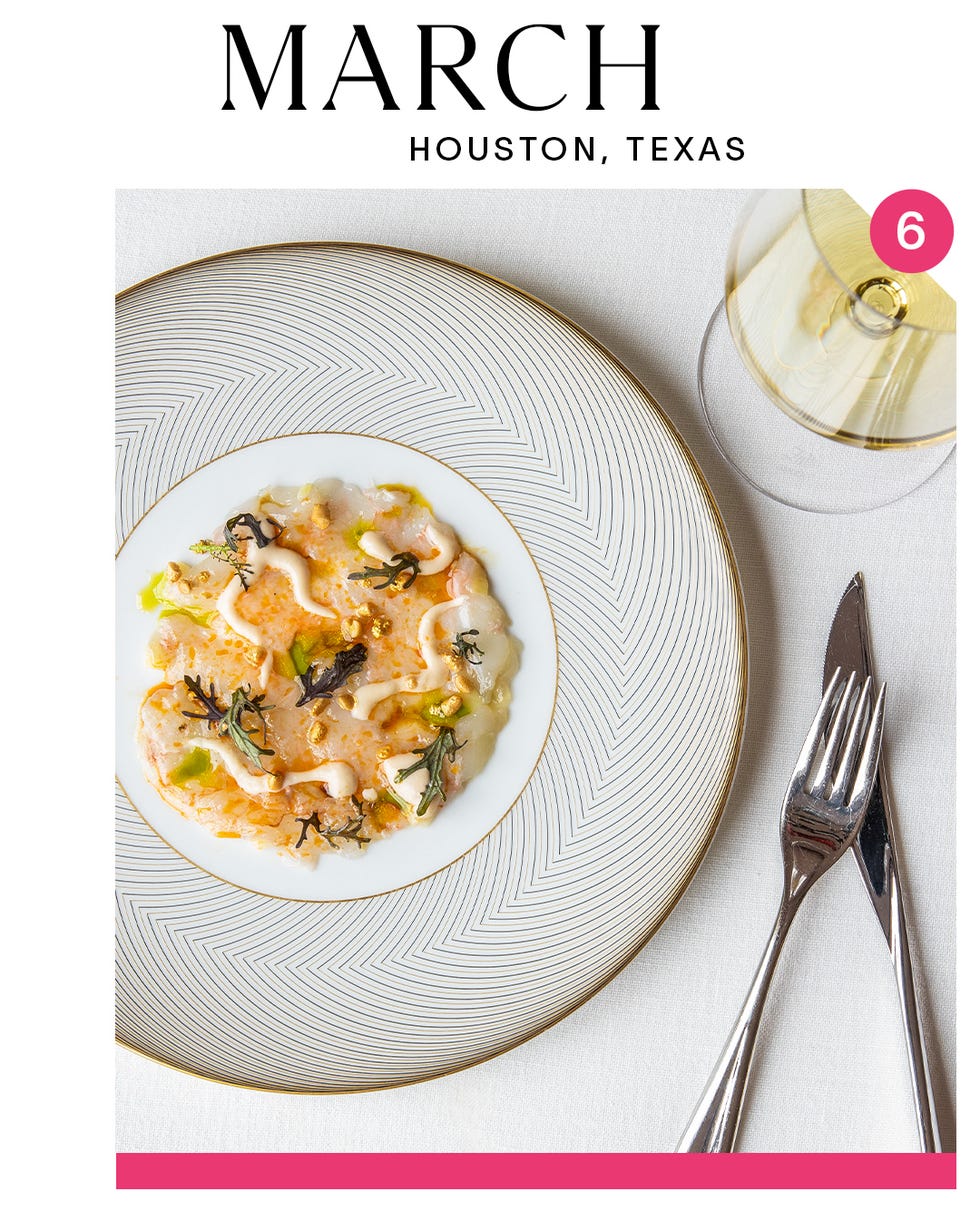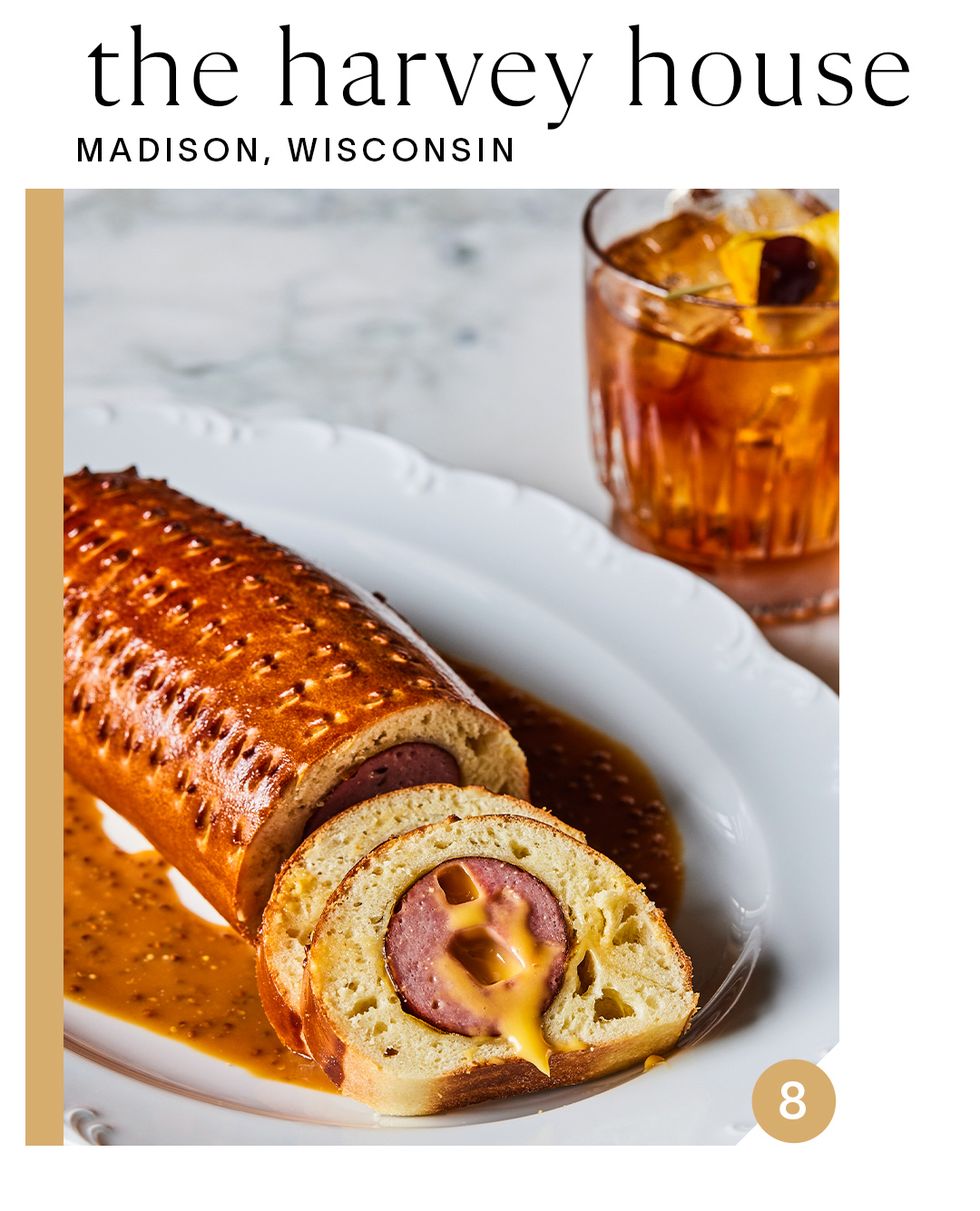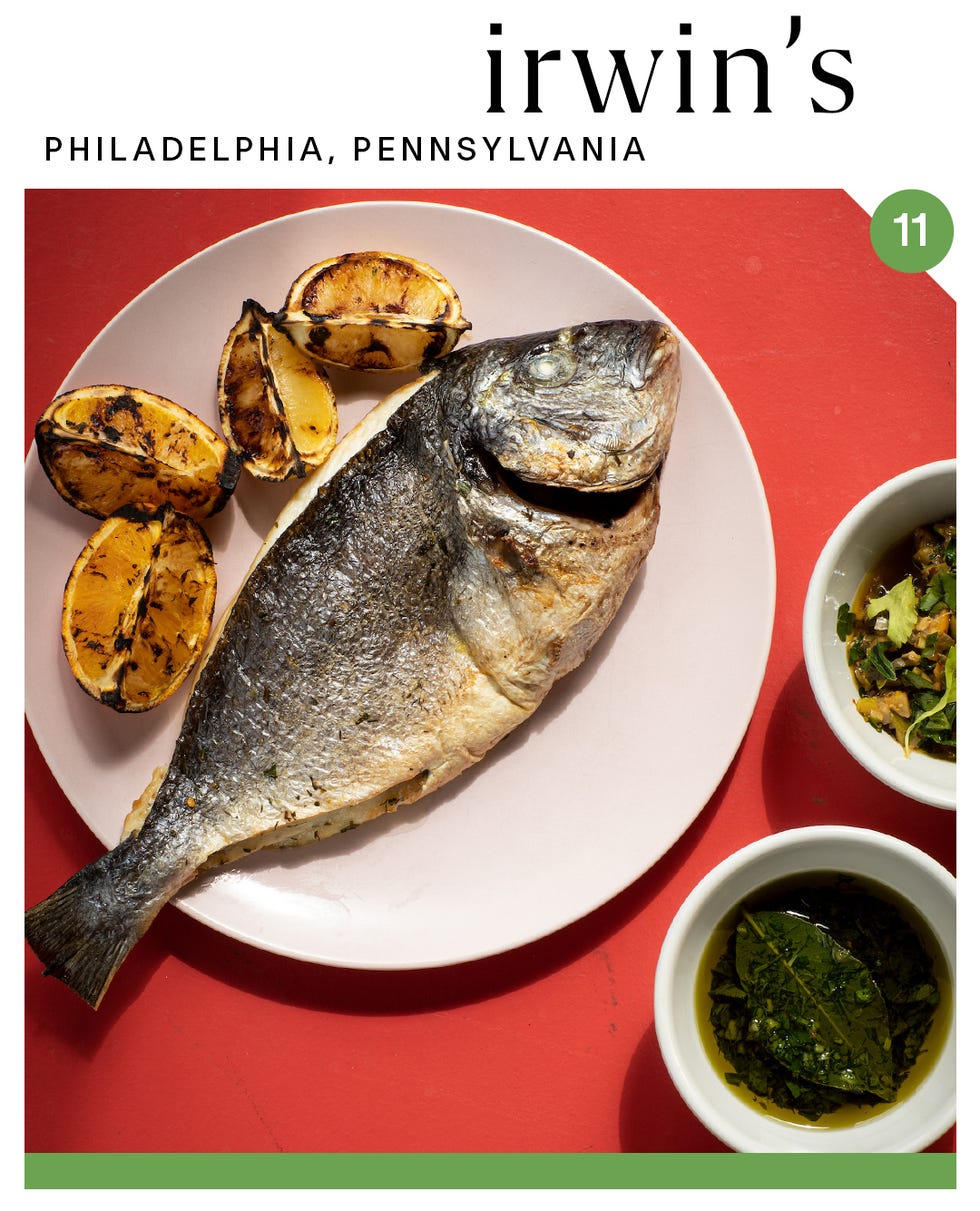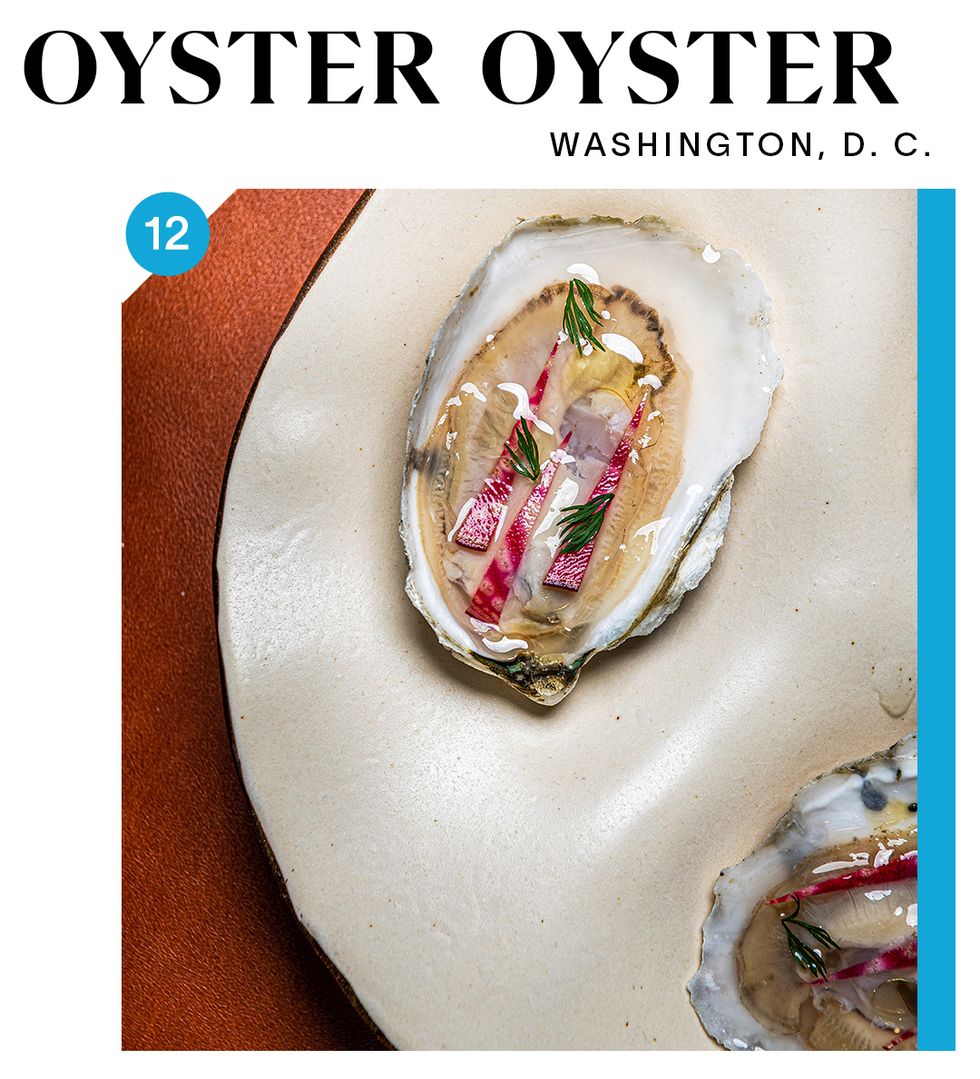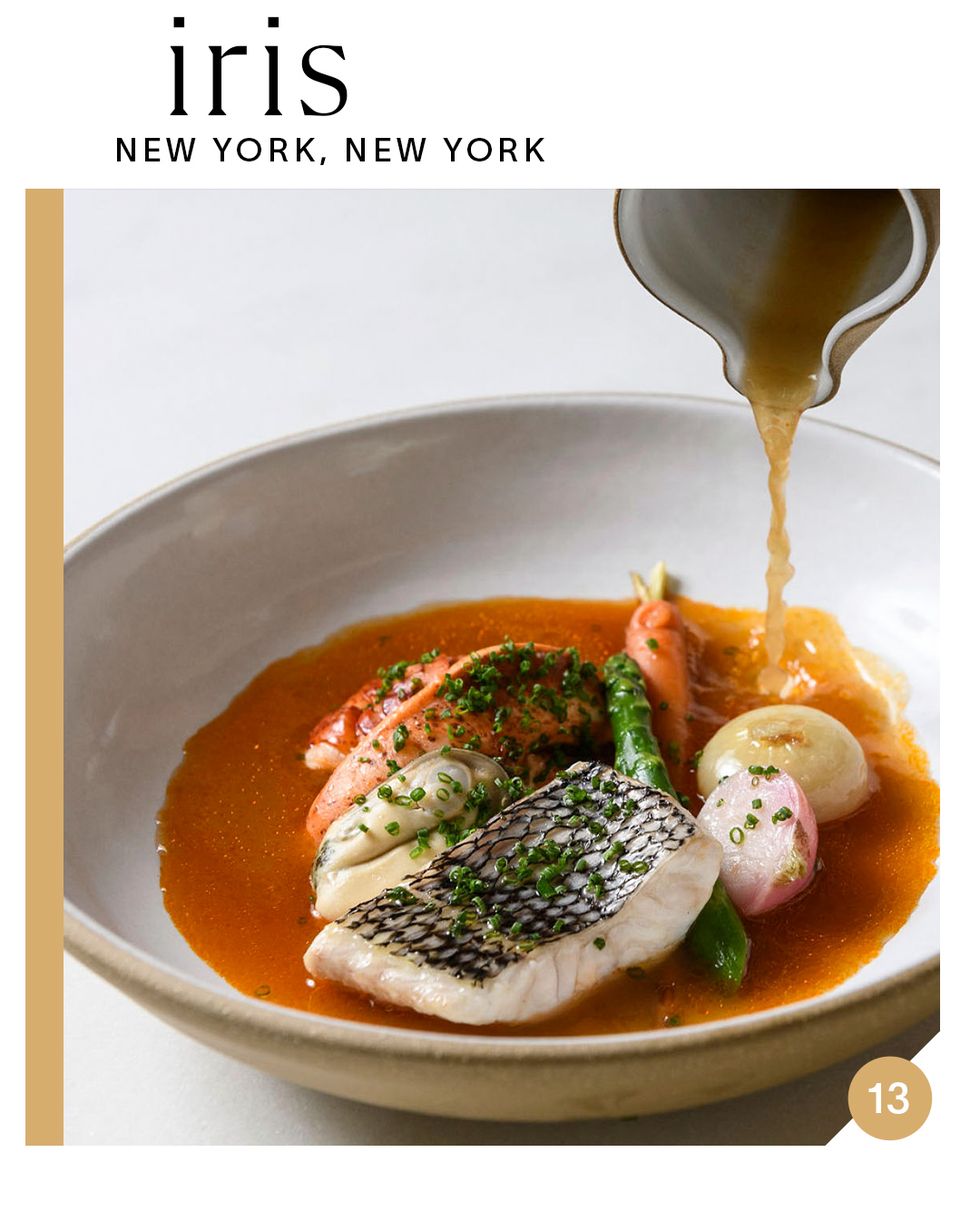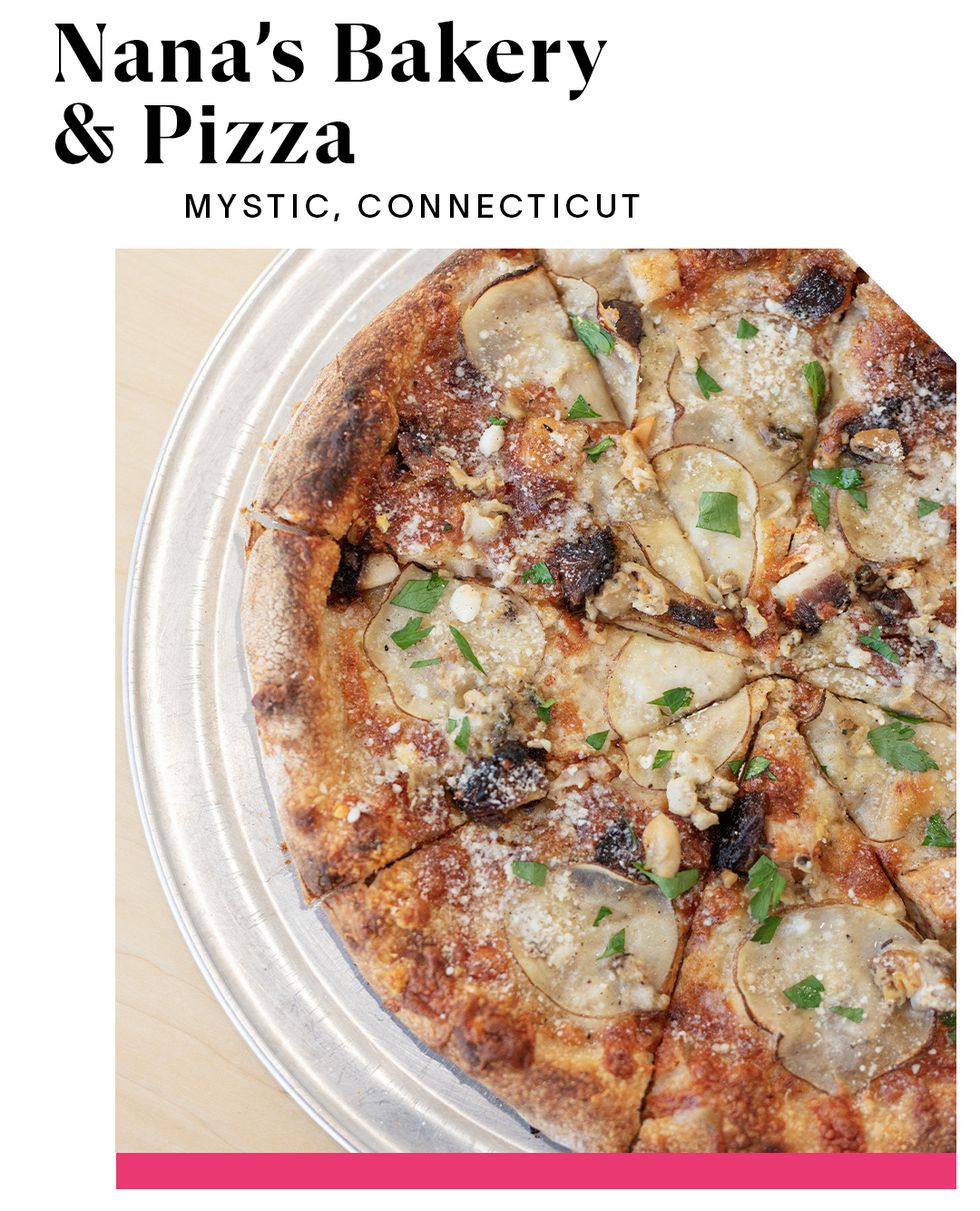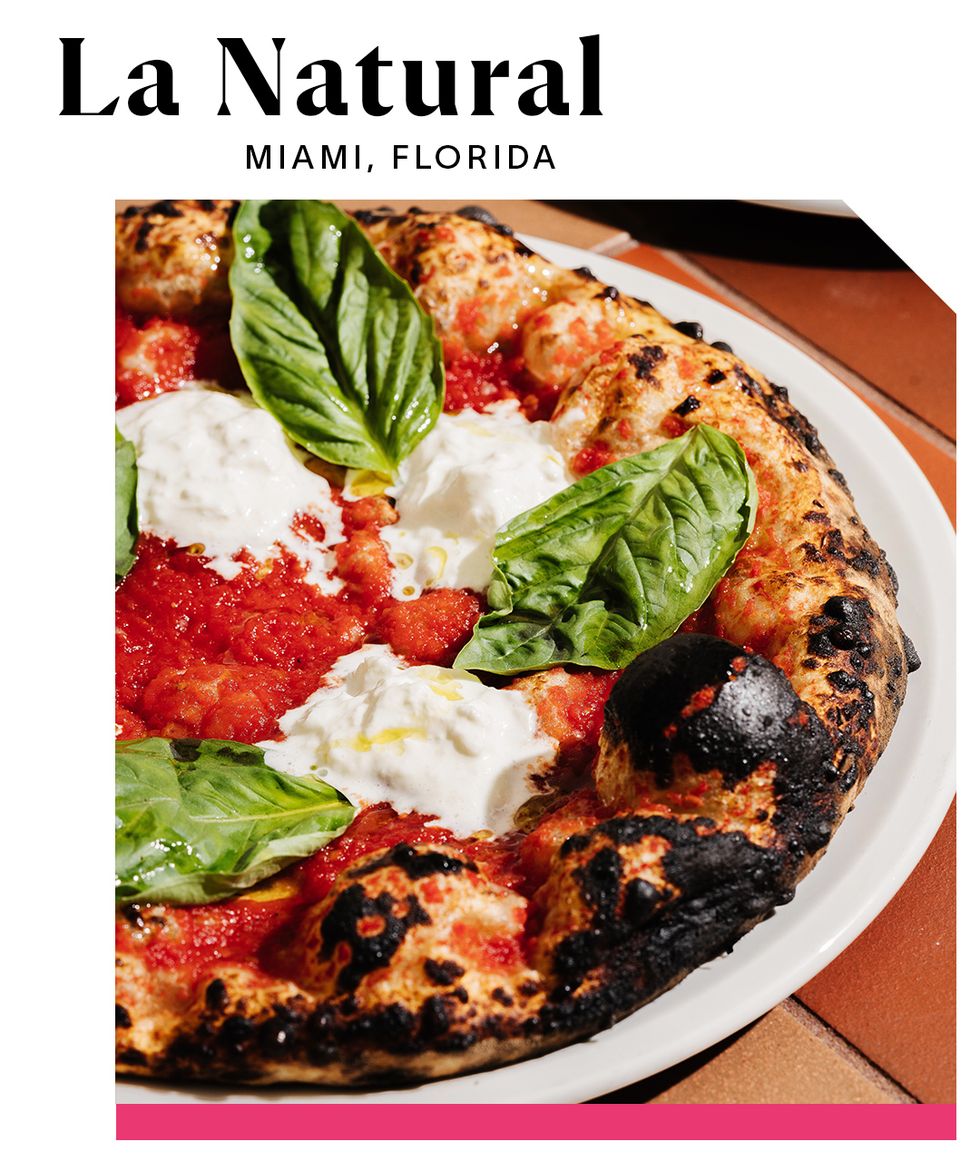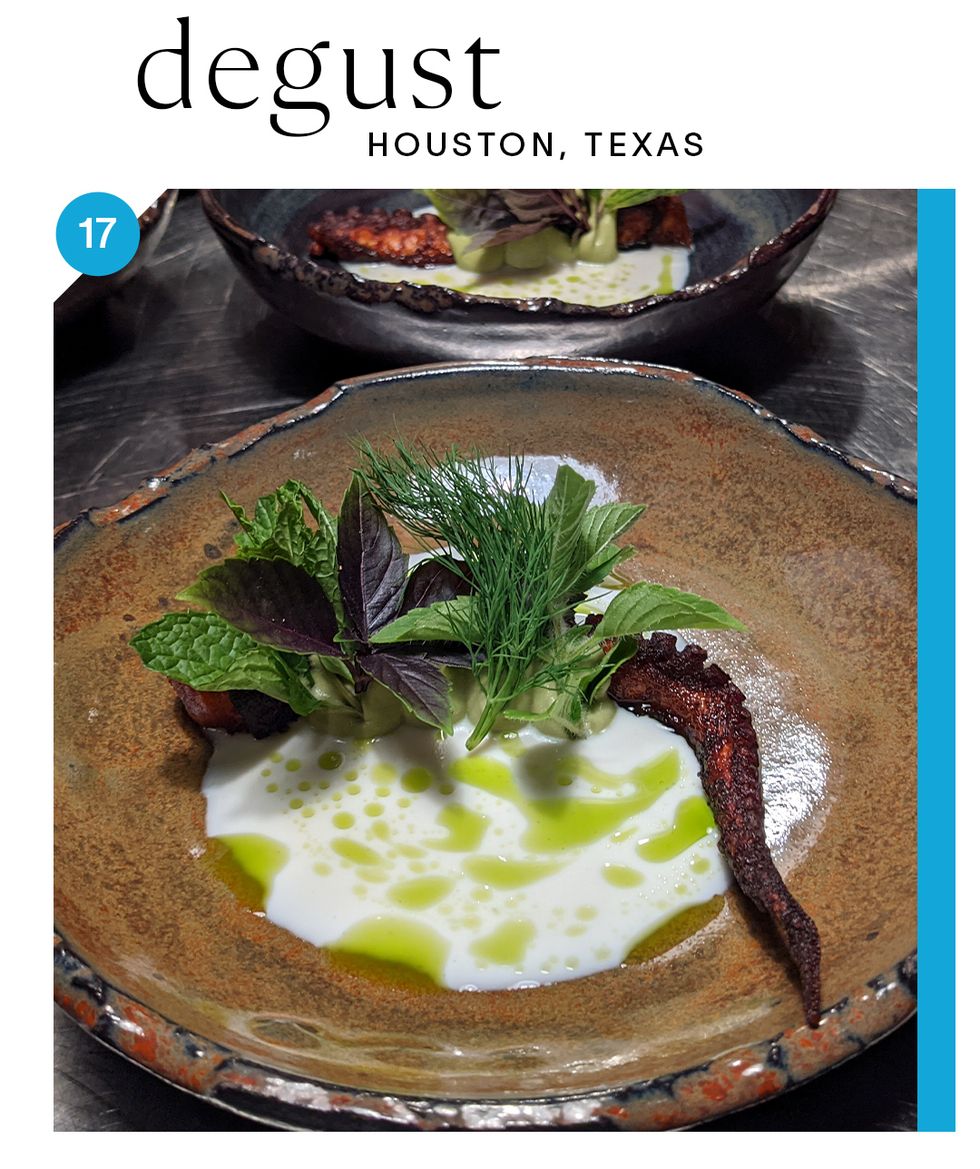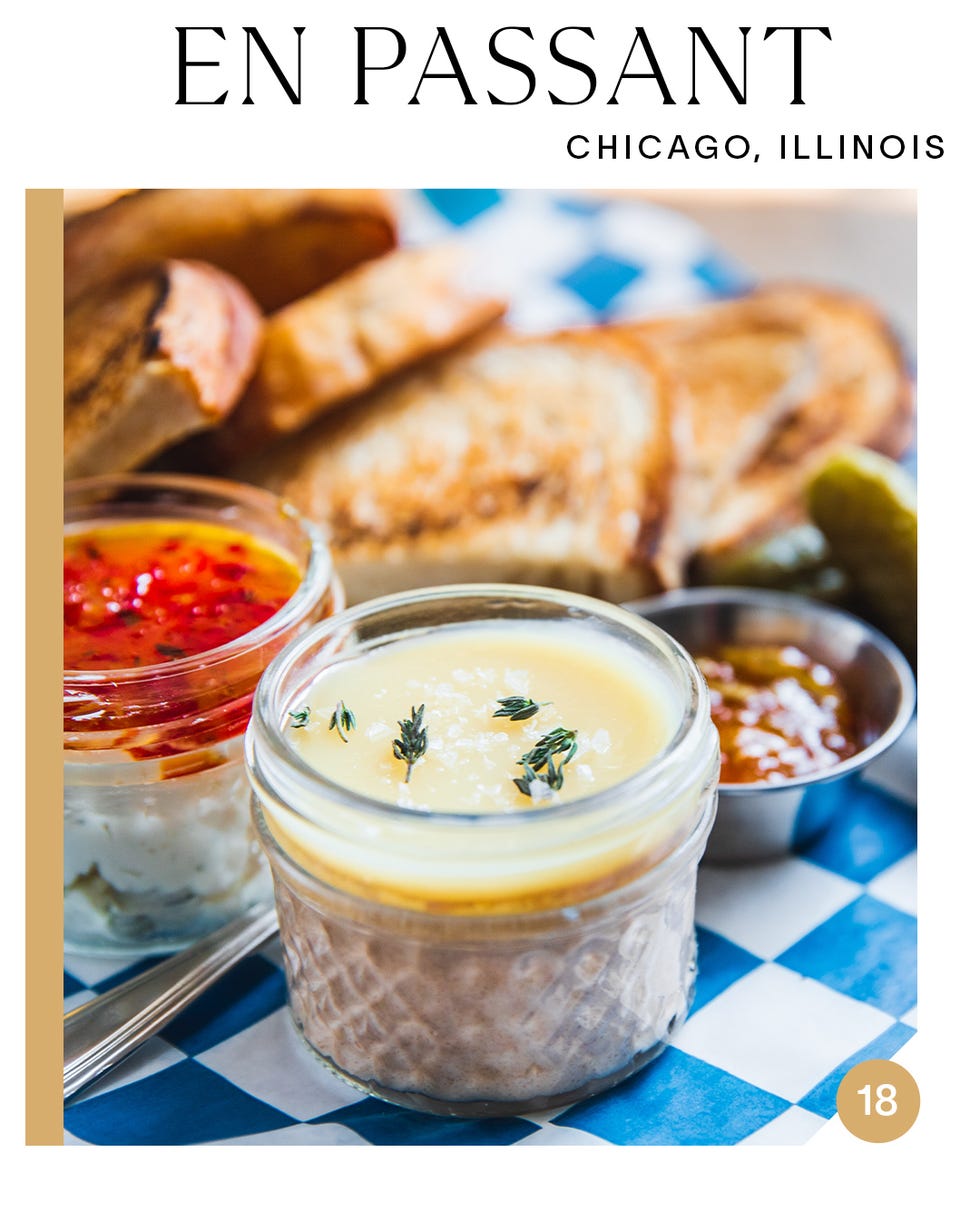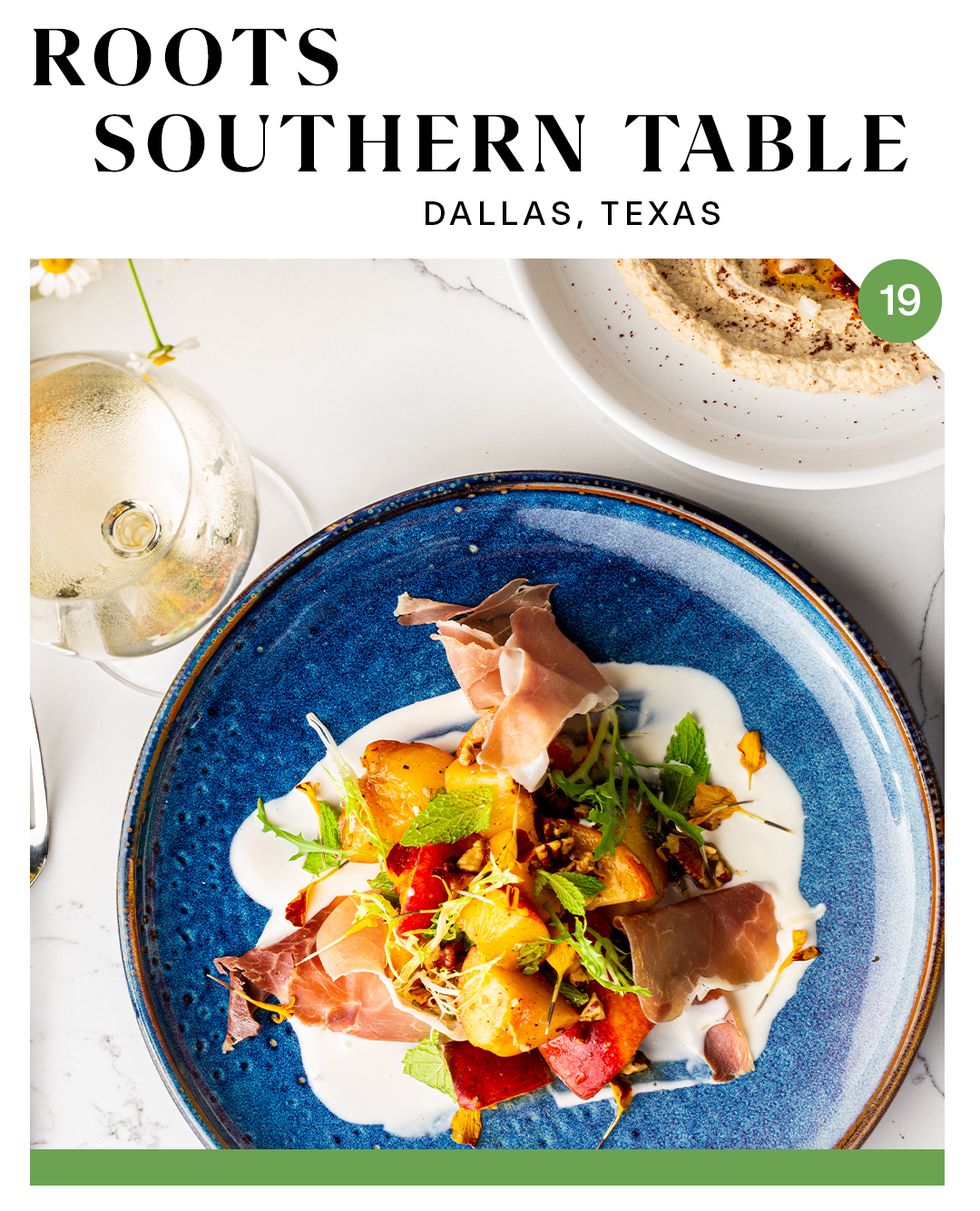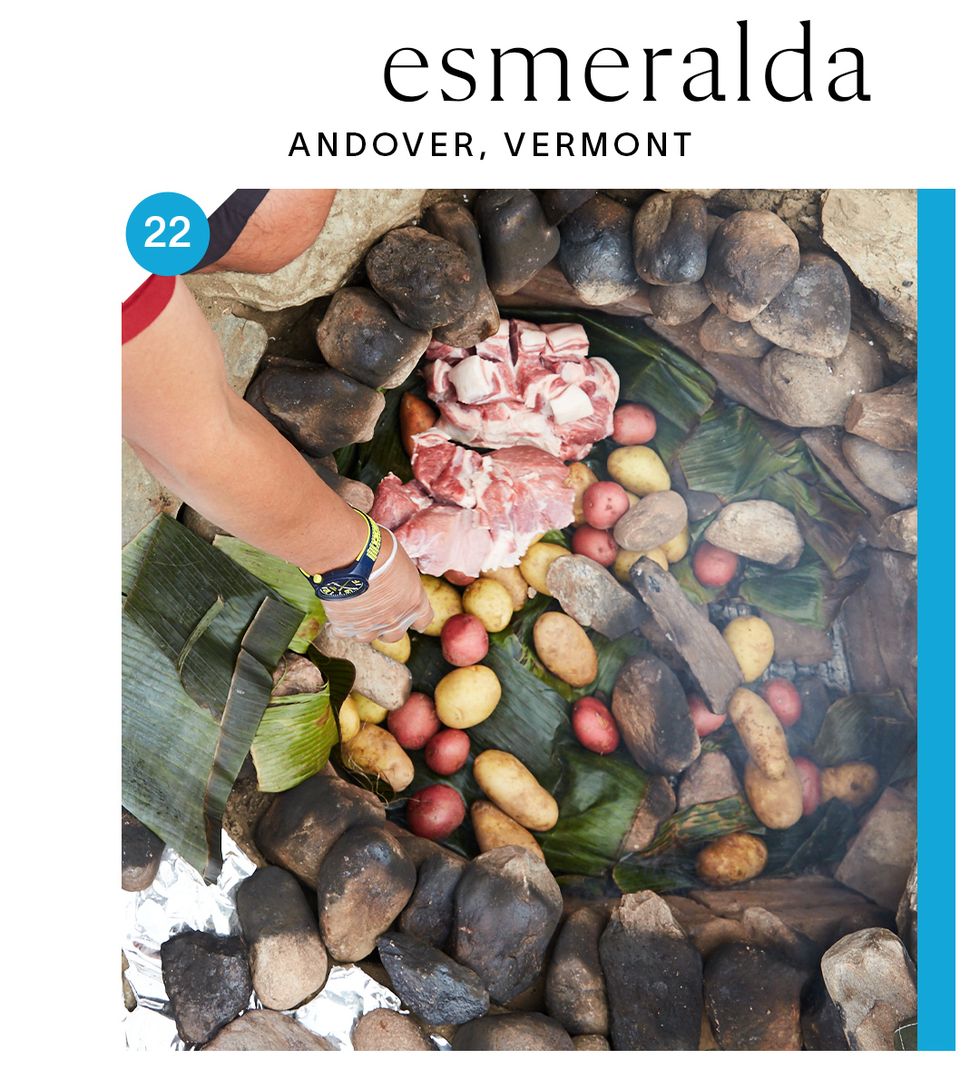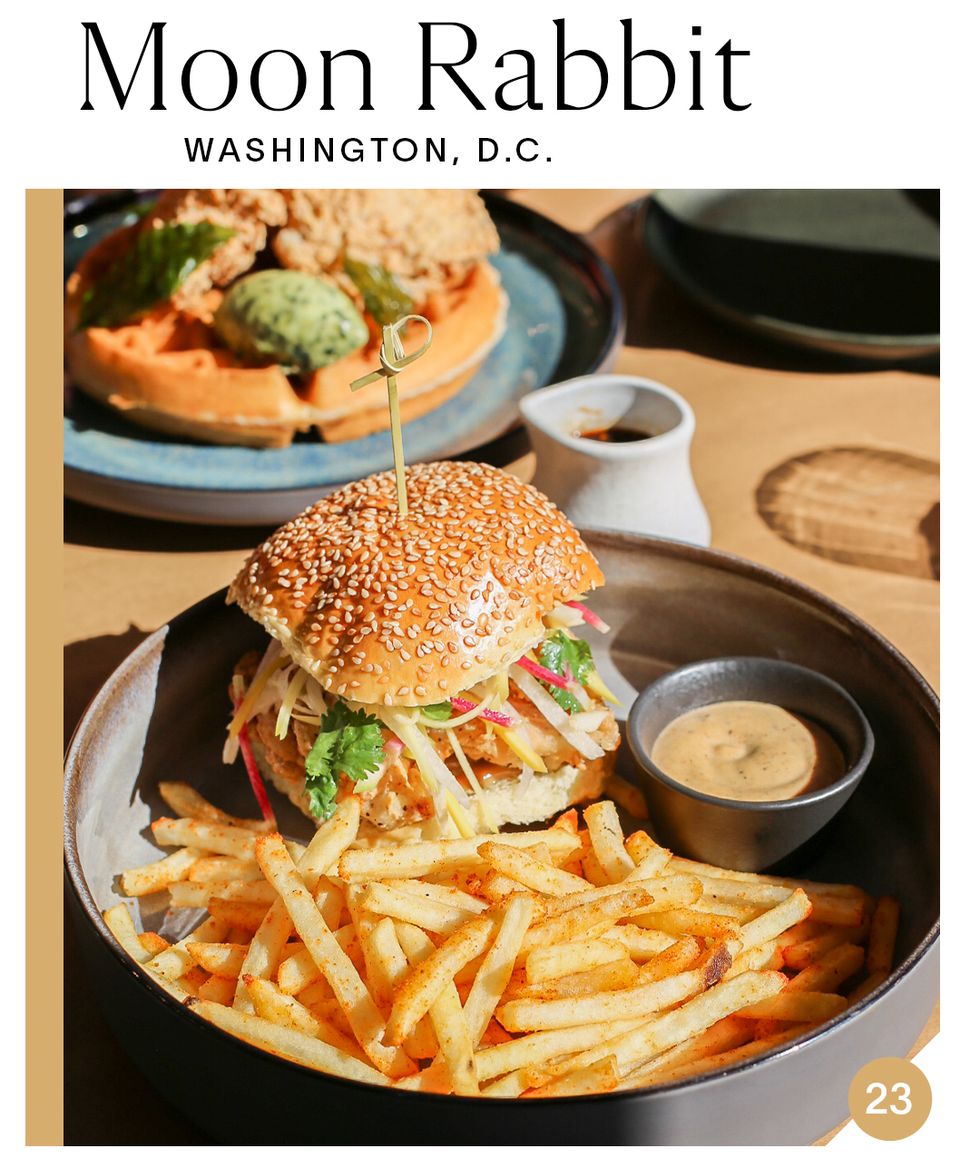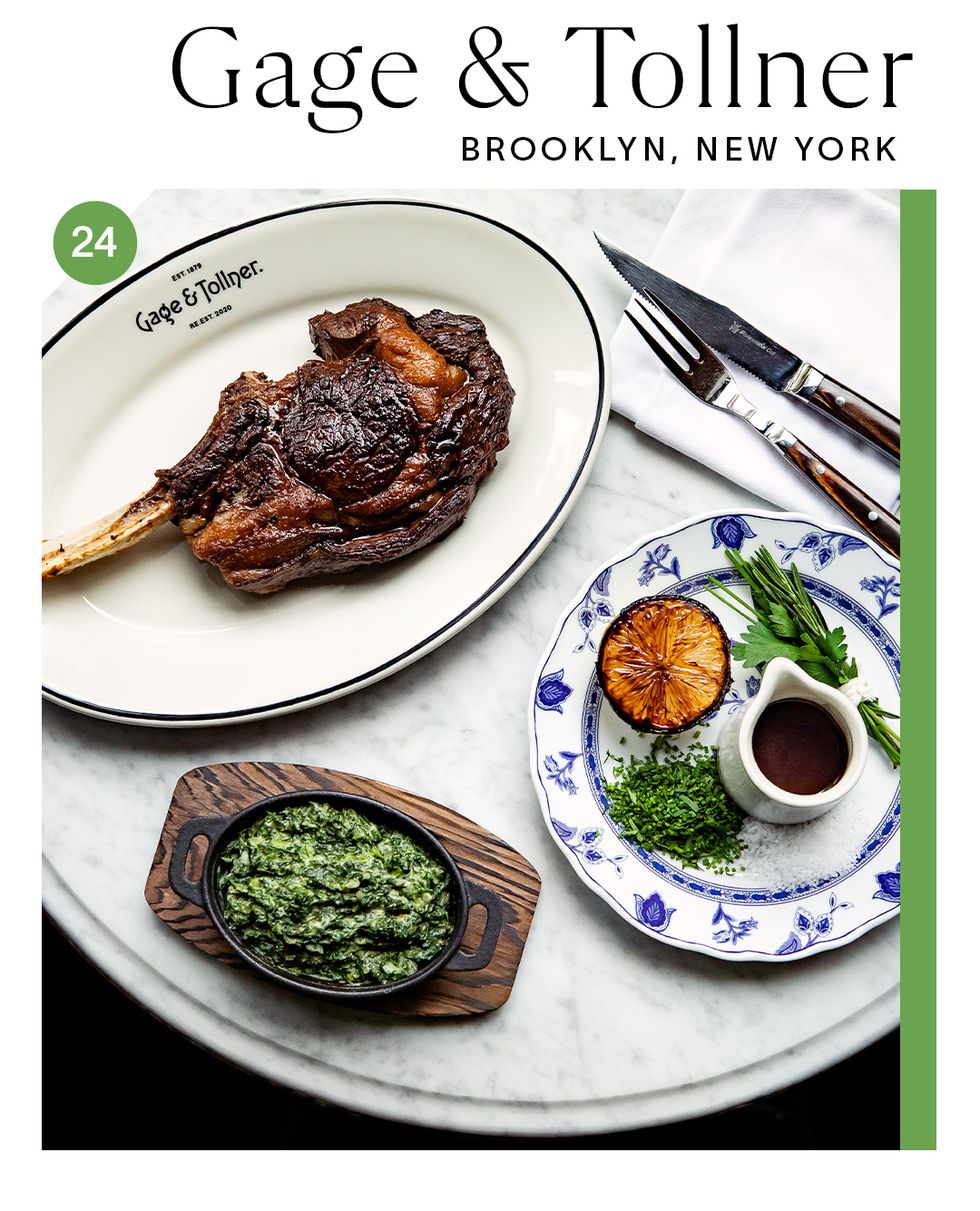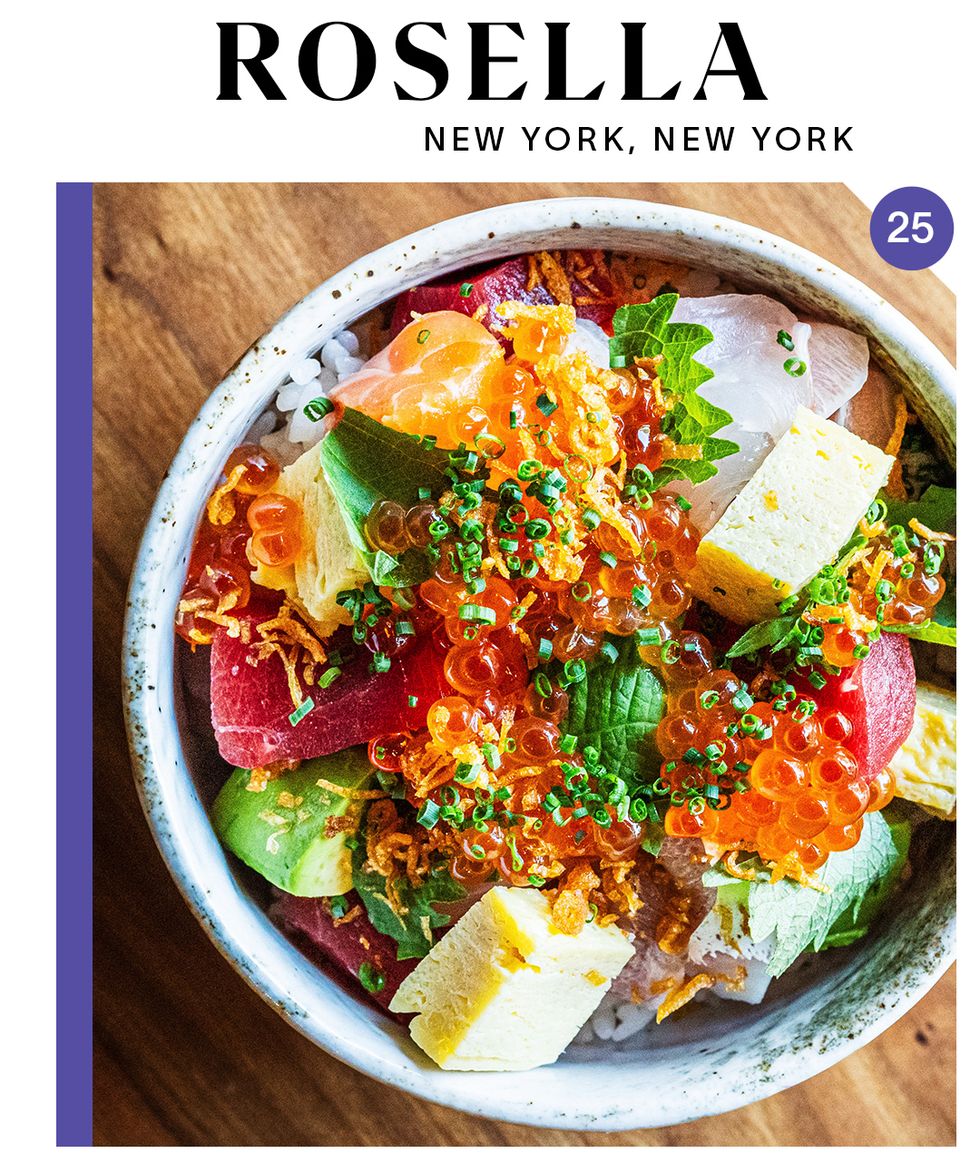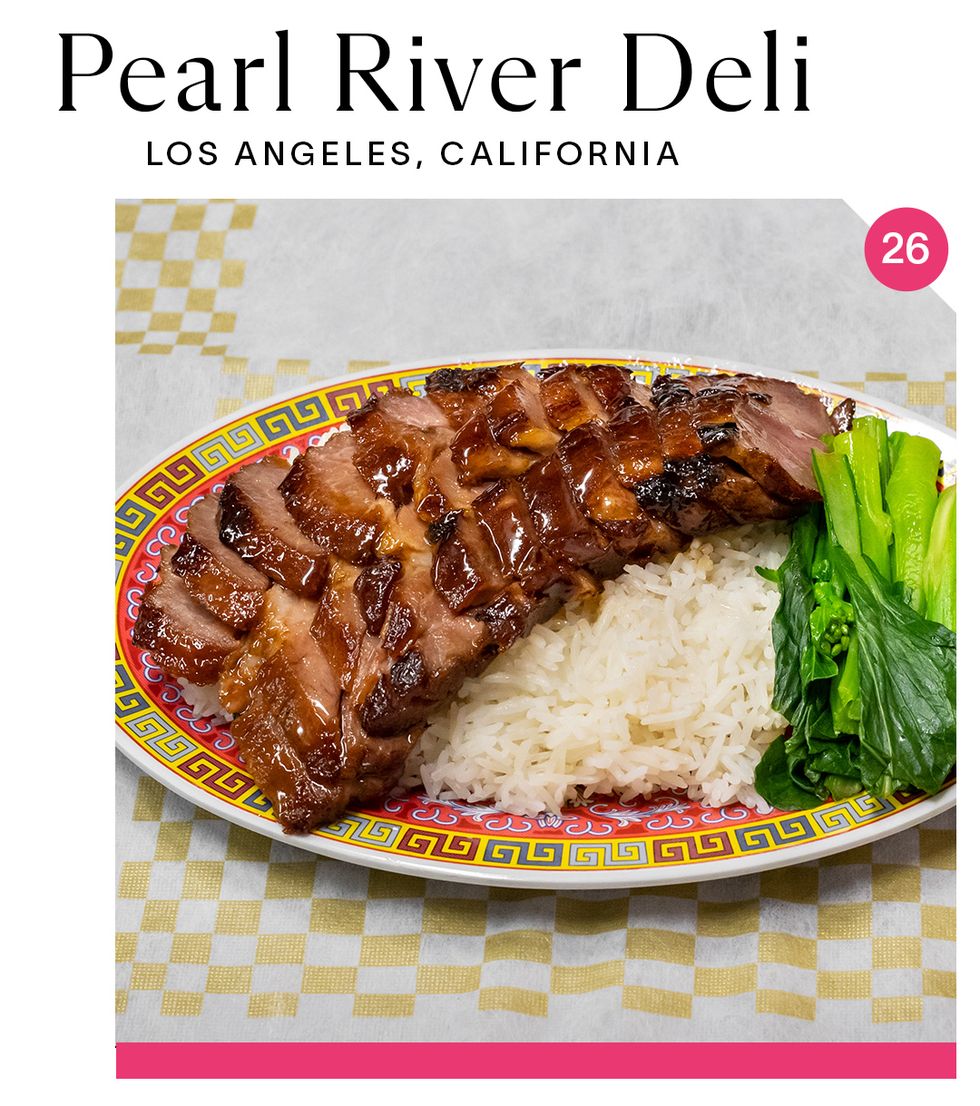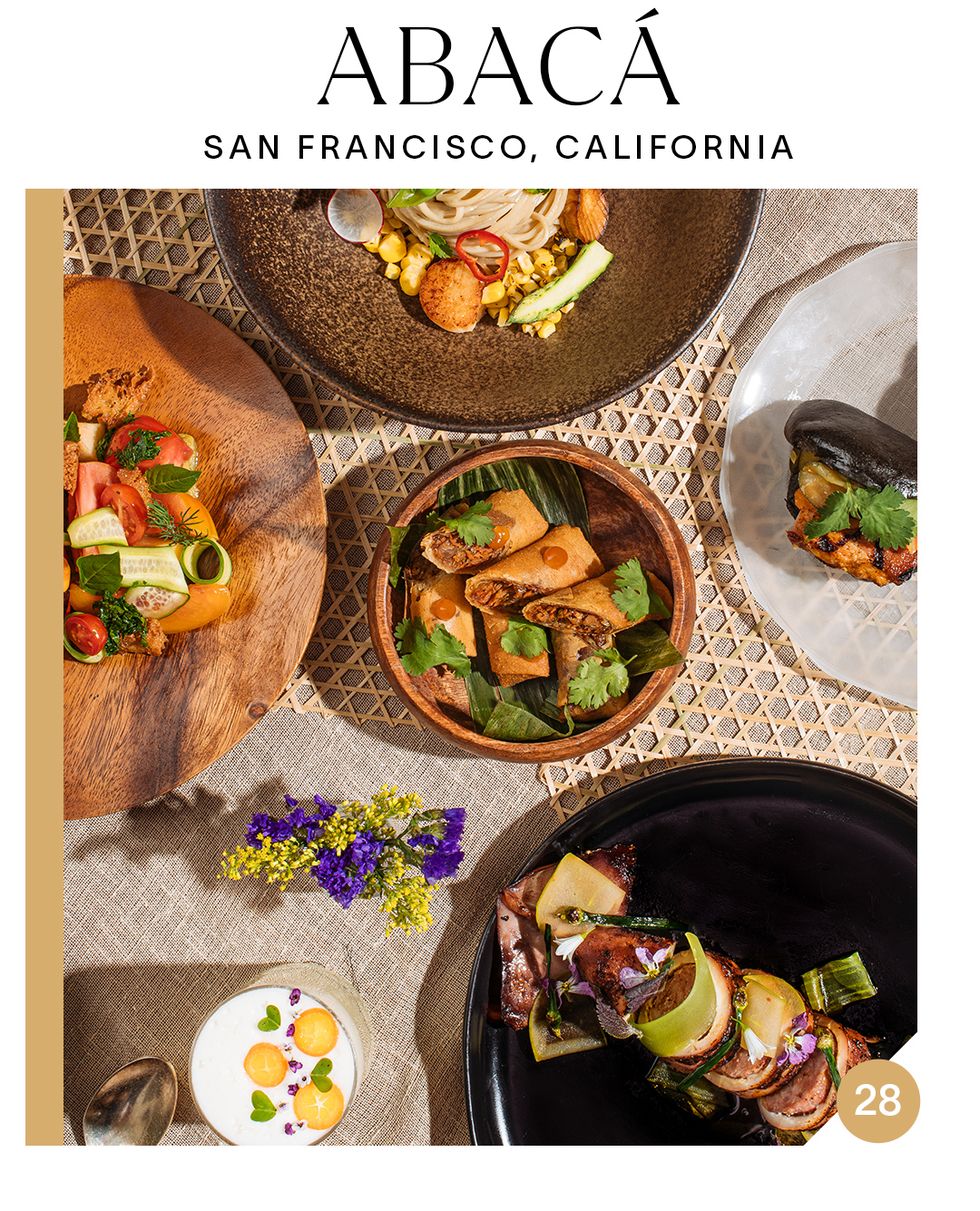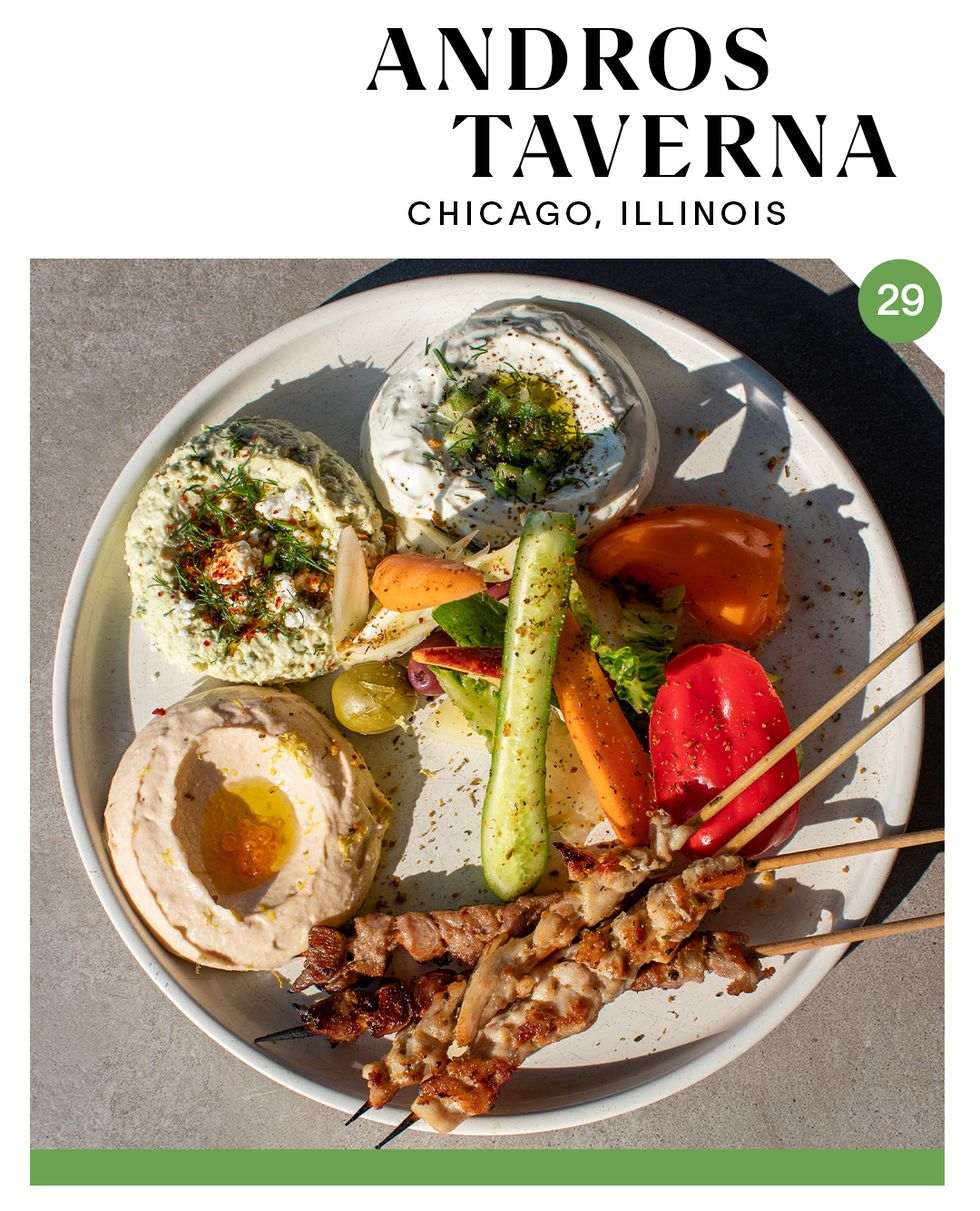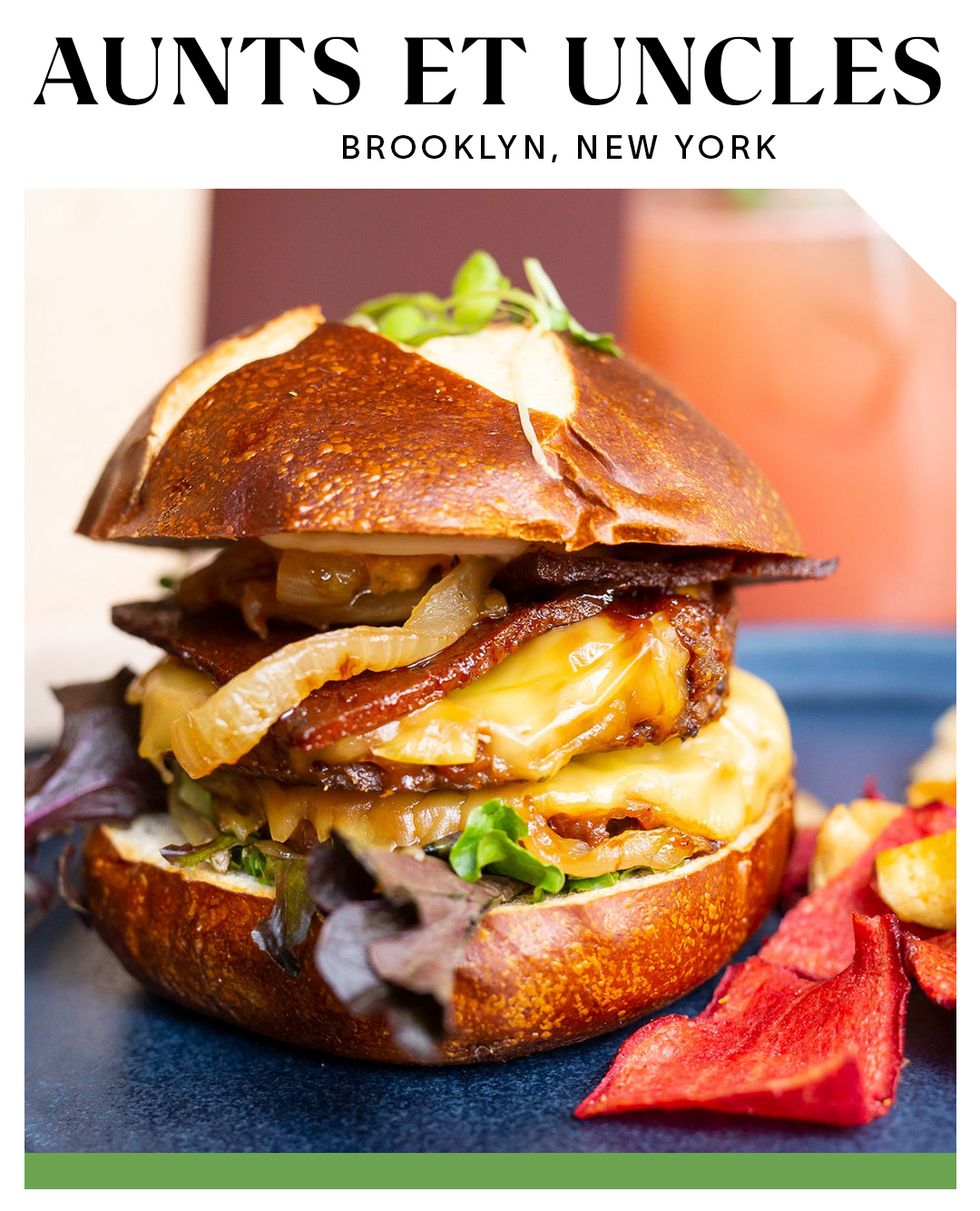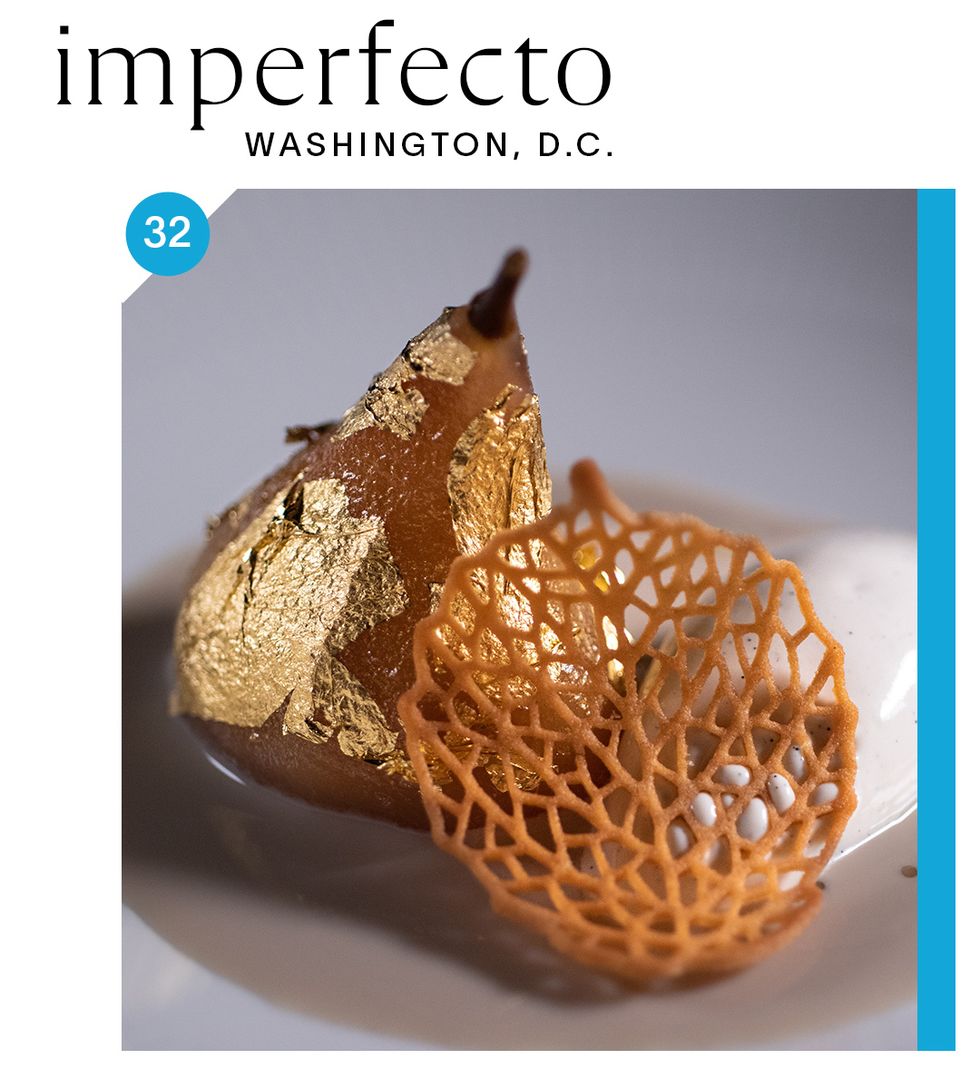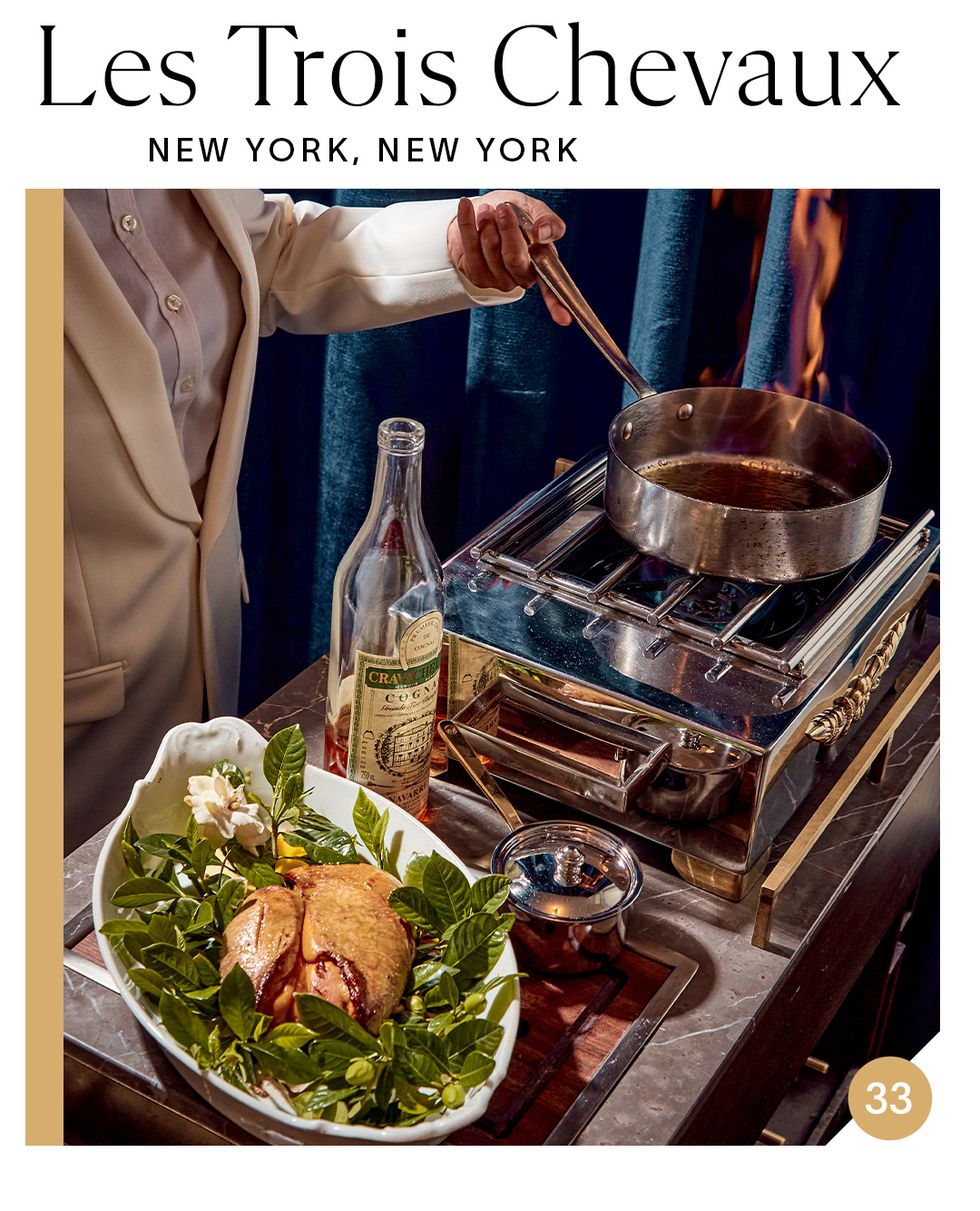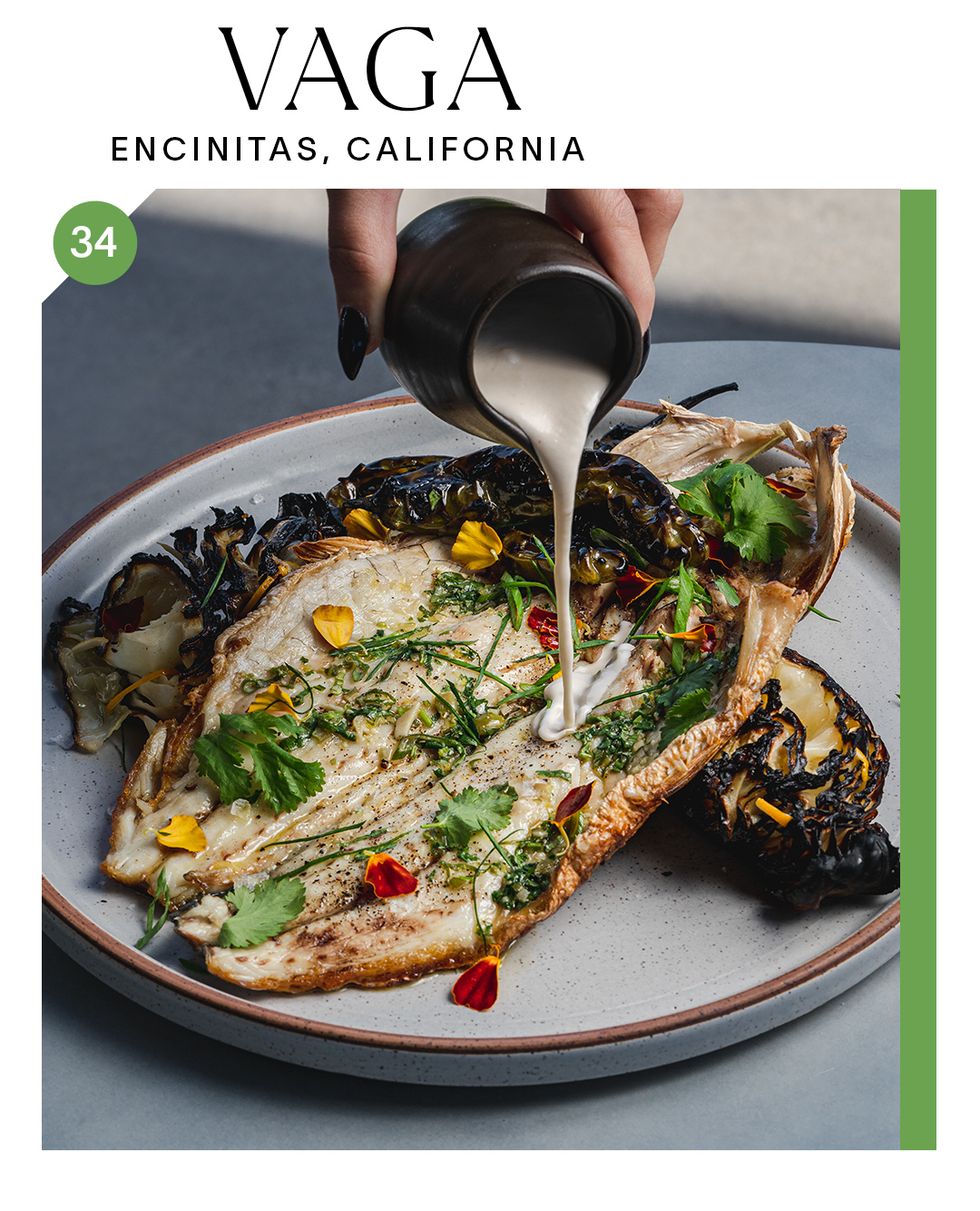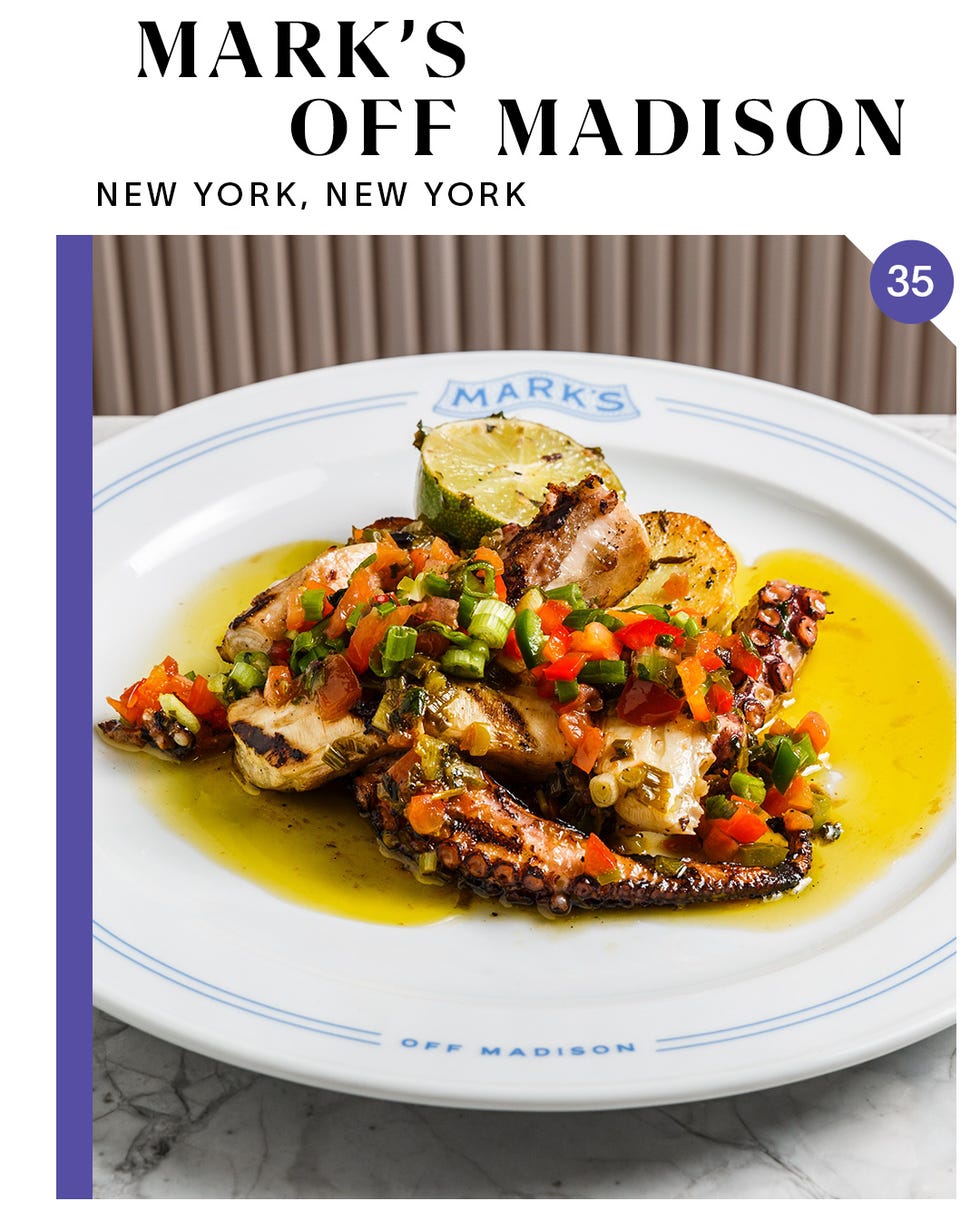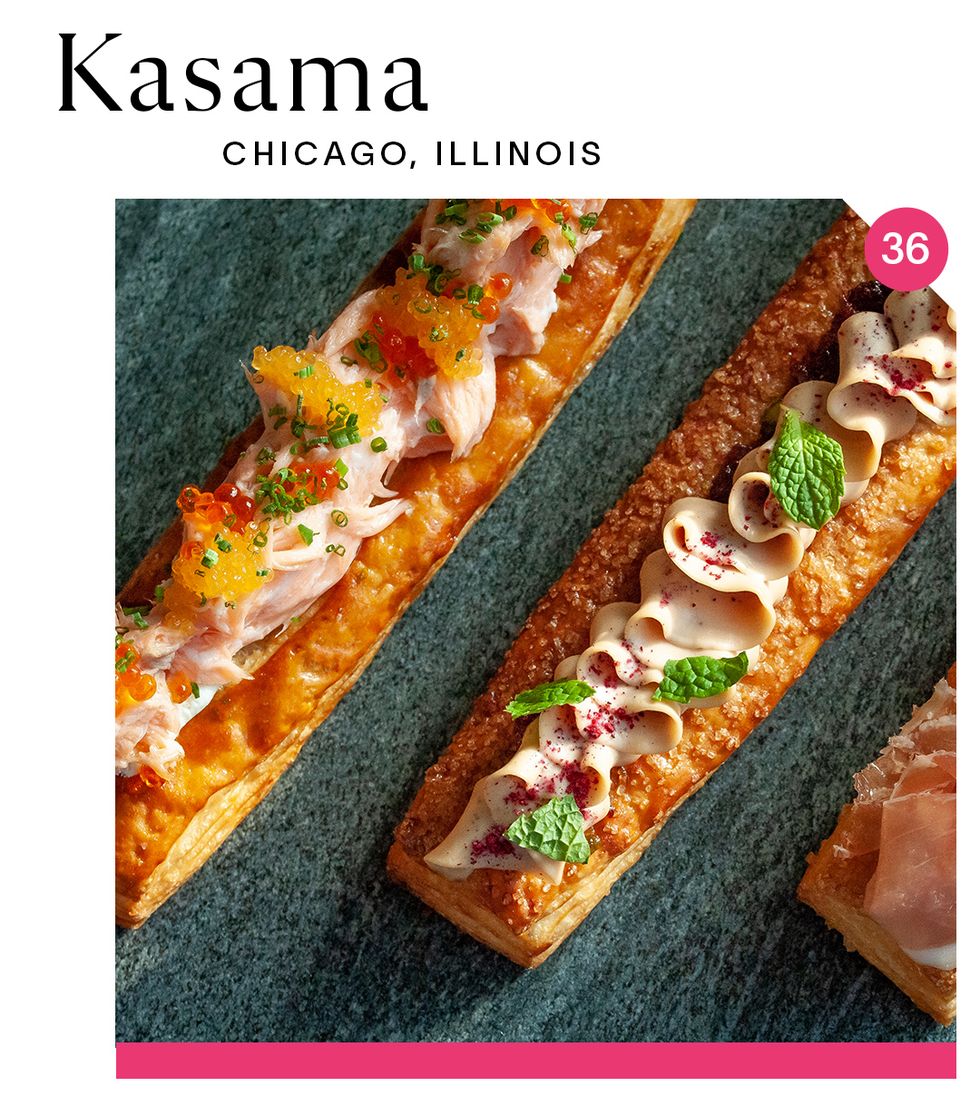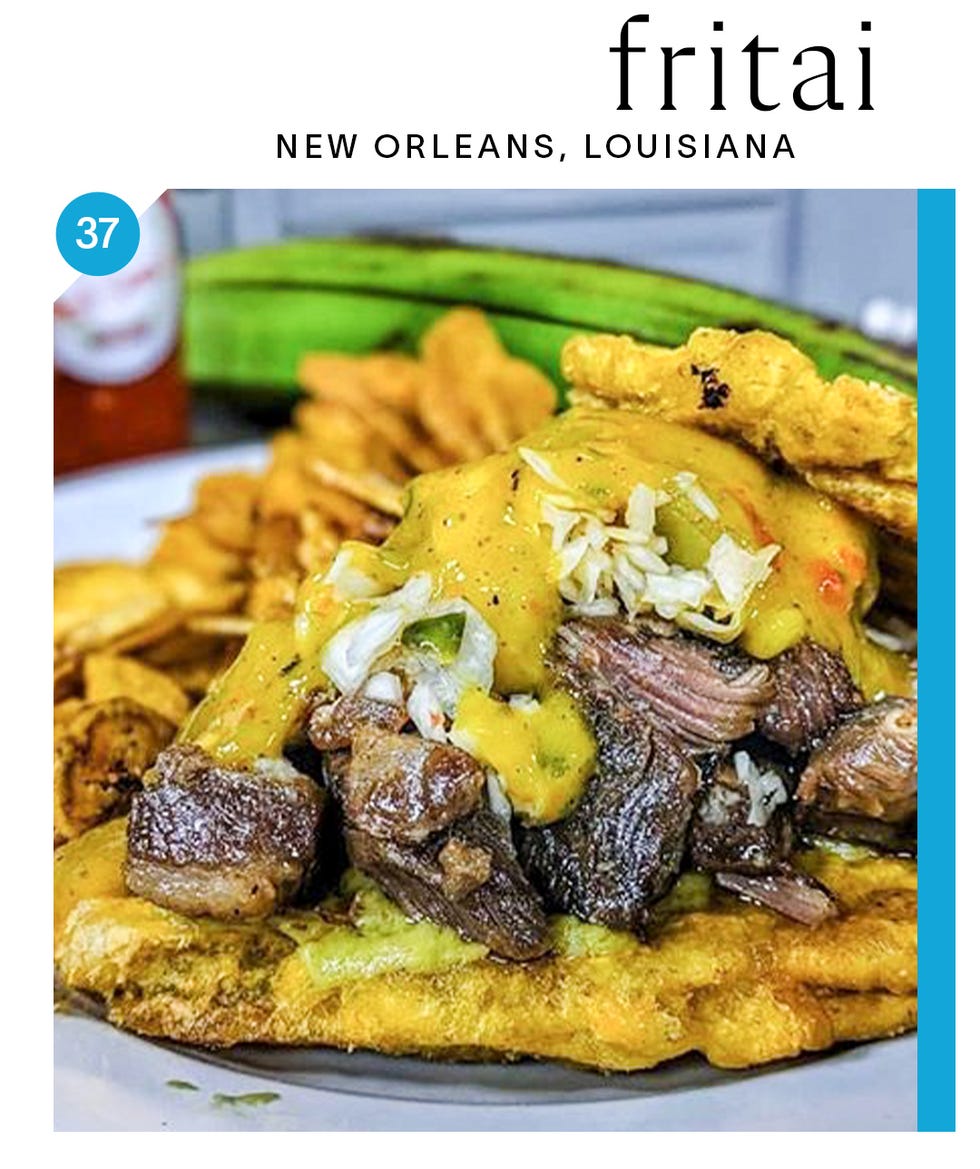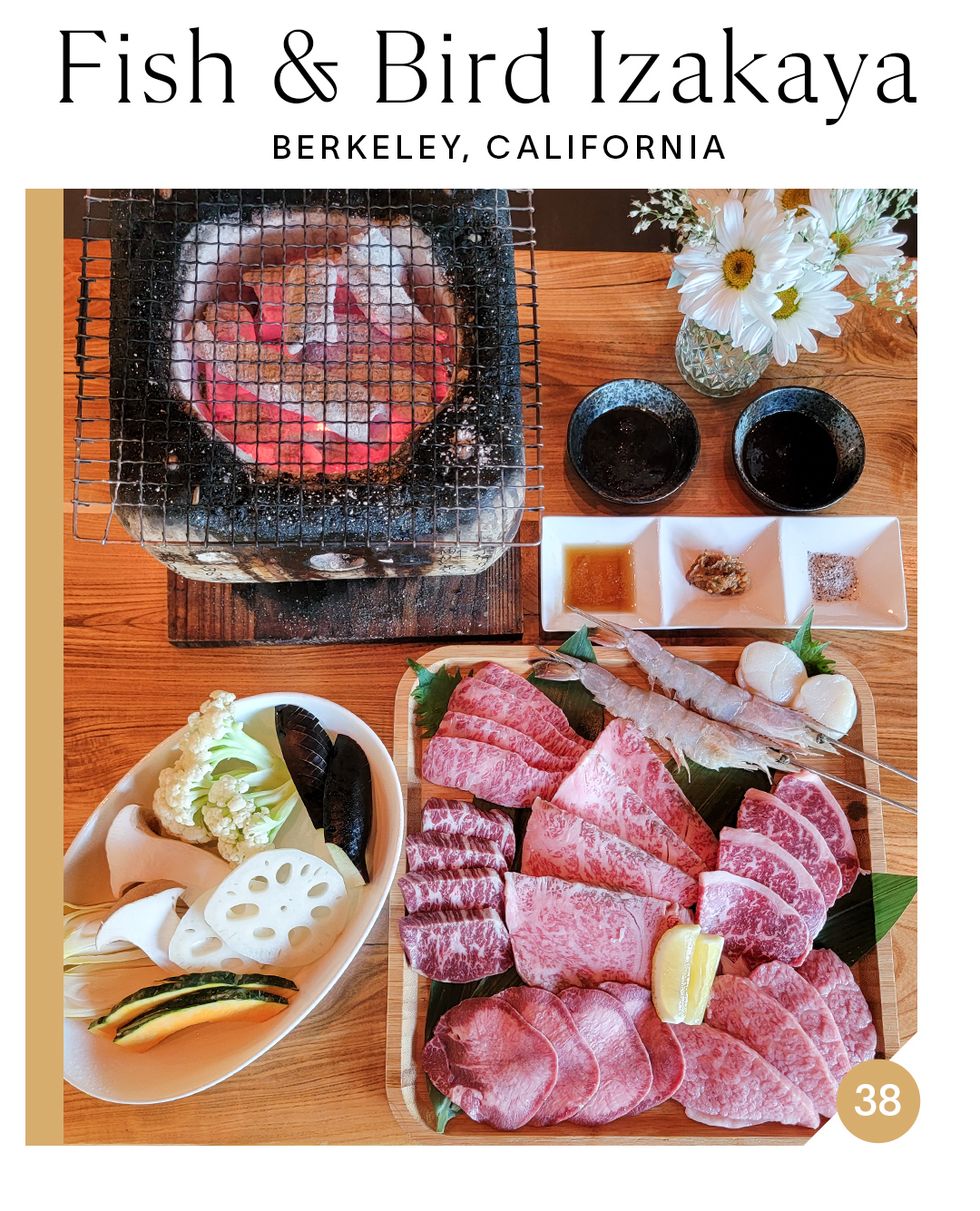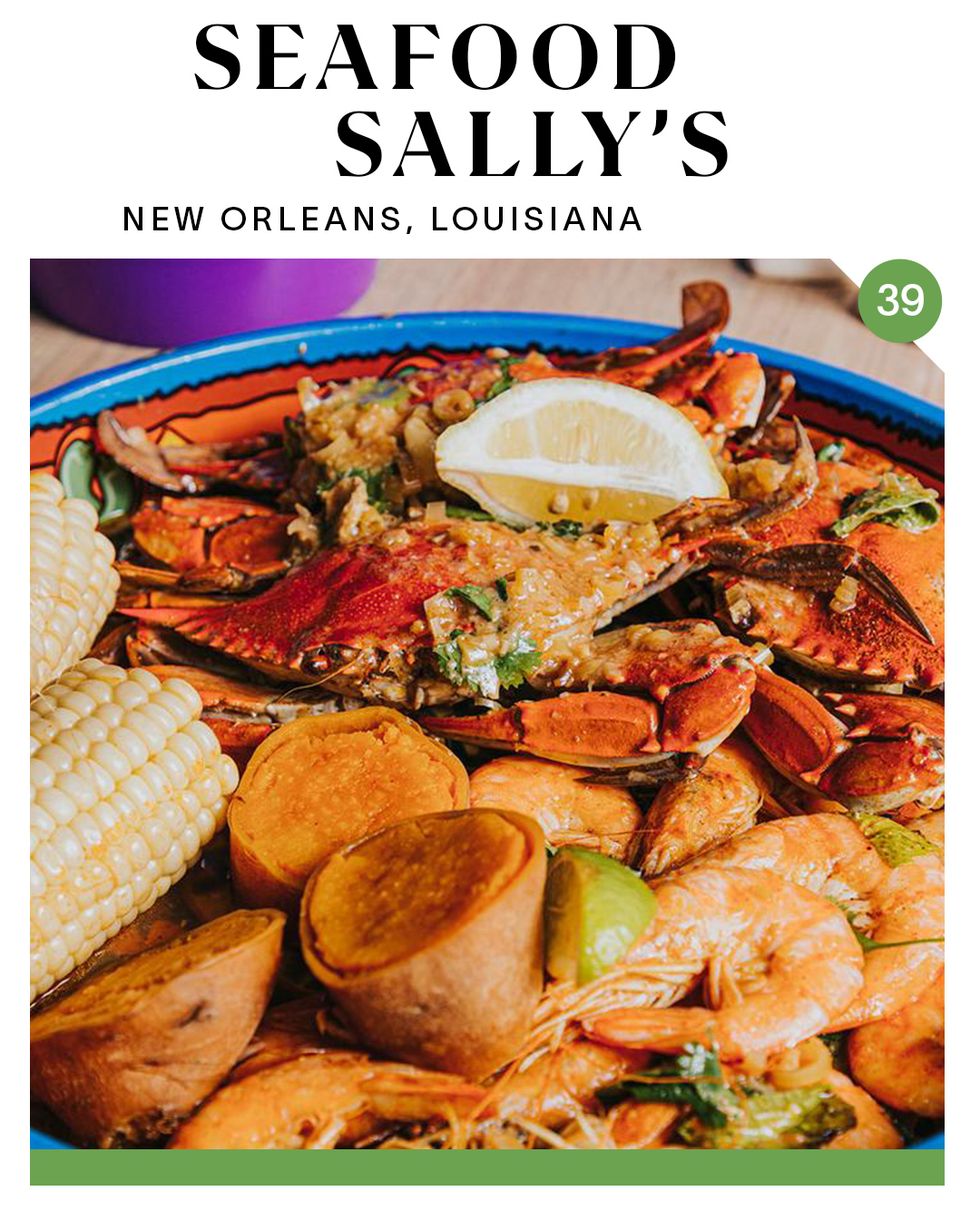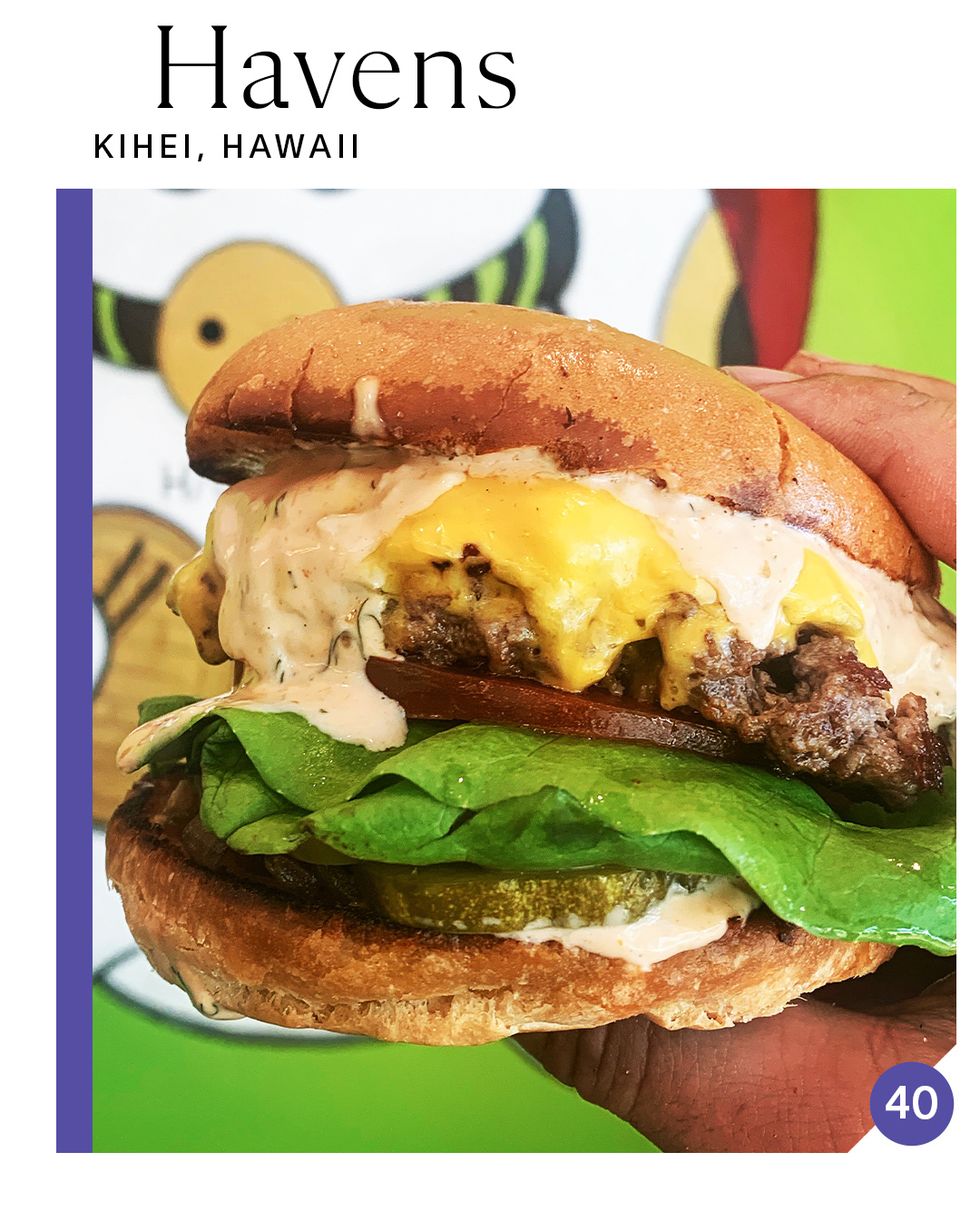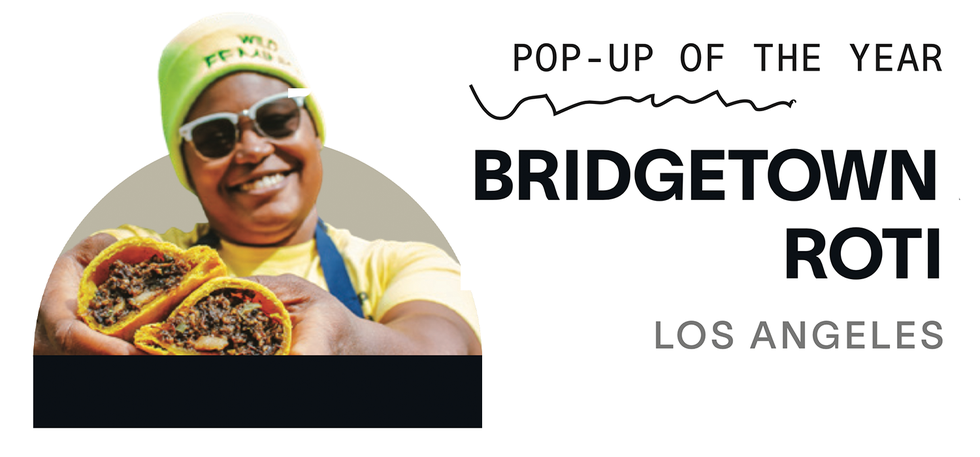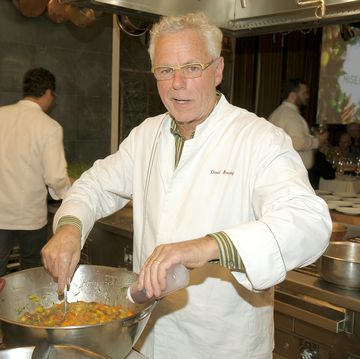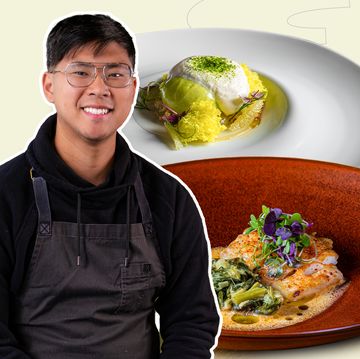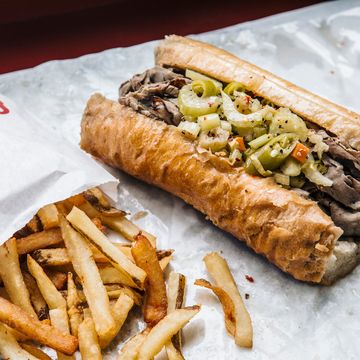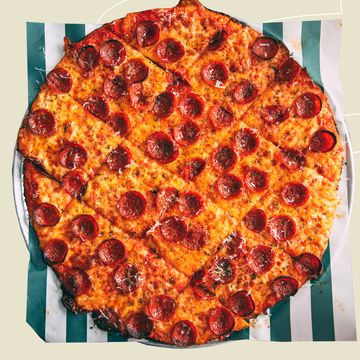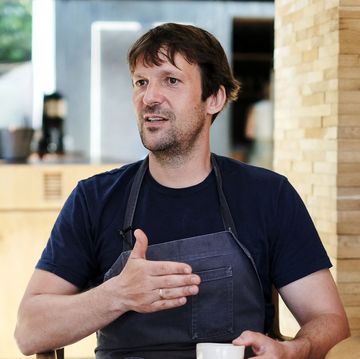Wanderlust is a real thing. Hunger is a real thing. And in a year when you couldn’t stand to look at your Instant Pot anymore and had to delay that vacation to Paris, when you craved something more than travel shows and takeout, the most satisfying way to feed the need for a journey was to go to a restaurant, feel taken care of, and try at least one thing from the menu that you’d never had before.
The transportive power of food, the soul-stirring nature of hospitality—real things, too. This is all to say that in these not normal times, we need both the normalcy and the escape of restaurants now more than ever.
And we want to support an industry that still needs it. So, to shine a spotlight on a larger number of our favorite new places this year, we enlisted not one, not two, but four people to eat around the country: seasoned food writers Omar Mamoon and Joshua David Stein, our former food and drink editor Jeff Gordinier, and yours truly. Together and separately, we traveled thousands of miles and dined at hundreds of restaurants to deliver a list nearly twice as large as last year’s.
Get unlimited access to Esquire's Food & Drinks coverage. Join Esquire Select.
As we ate around America, we were drawn to food made with raw, elemental fire and charcoal—it’s never gone out of style, after all these millennia. The char called to us whether it graced the elote from a Sonoran grill at Bacanora in Phoenix, the ends of gyro meat at Andros Taverna in Chicago, or the dry-aged Wagyu at Austin’s Hestia. We couldn’t stop talking about delicious, nonpreachy vegan meals that would make even the most ardent meat eater crave vegetables. (Here’s a mini list, the most transcendent vegan options of the year: 1. Fried lasagna at Cadence, New York. 2. Mushroom, corn truffle, and potato at Oyster Oyster, Washington, D. C. 3. Sunflower bread and butter at Eleven Madison Park, New York.) We even fell back in love with multicourse tasting menus at Chicago’s Ever and Houston’s March. In the hands of the right team, they can still be a sublime, luxe experience rather than the pricey, interminable drag they oftentimes veer into. And you’ll see that there’s more New York representation than in previous years. Why? Because New York is undeniably back in a big way.
Perhaps most significant: We found ourselves digging into comfort, sure, but we also leaned into the unfamiliar. Into adventure. Eating at the very best restaurants is like winning a ticket to another place, another time. To the past and the future—and sometimes both at once. To Macau via pork chop; to the graciousness of a Wisconsin supper club when your martini glass is refreshed with a frosted one; to central Texas and the Black South through brisket; to a Scandinavian grandmother’s kitchen by way of an apple-pie crust ladened with lard; to a precolonized America via the sweet, nutty flavors of hand-harvested wild rice.
Our minds have been warped. The experiential miles we logged will last us a very long time (or at least until we start reporting next year’s Best New Restaurants list). And we hope you’ll be able to take some of these culinary, cultural journeys as well. When you’re ready, get out there and support these places, those on our previous years’ lists, and any of your local favorites. Because sometimes that escape is closer than you think. —Kevin Sintumuang
Eat. Sweat. Swoon. Drink. Repeat. At this Technicolor corner of the Lower East Side’s Essex Market, chef Chintan Pandya and restaurateur Roni Mazumdar create Indian food with a visceral, transportive energy by showcasing the fringes of the cuisine: a paplet fry, which is a whole, fried pomfret fish, dusted with ginger and cumin, an ideal partner to beer; a fiery, funky gurda kapoora, made with goat kidneys and testicles; a Bengal curry with baby shark. It is the stuff of homes and street stalls thousands of miles away. And yes, it is spicy. It calls for you to put down the phone. The tapping and scrolling can make the world feel small, but is that really the case? Eat, sweat, swoon, drink, repeat, and realize: There’s so much to this world, so much to try. Dhamaka at 119 Delancey Street, New York, New York —K.S.
There is a jar, neatly covered in an aluminum wrapper, like a yogurt cup. Open it and, poof, smoke wafts into your nostrils, and instinctively you lick the emulsions artfully placed on the underside of the wrapper. Trippy. The second course arrives with a tiny skull made of almond cream, as if to say, Get ready for a mind-altering ride, dude. And so begins a journey into chef Curtis Duffy and Michael Muser’s fantastical slow burn of a tasting menu, which, even with the serious modernist hijinks, is delicious and playful. (Yes, that’s Matthew McConaughey reading from his memoir on the bathroom’s speaker.) The pairings of esoteric wines are downright magical, an extra dimension to what feels like a mellow acid trip. Ever at 1340 West Fulton Street, Chicago —K.S.
Helen was a real woman who wore pearls and had a grill inside her house. Her facility with coals lives on in her grandson Rob McDaniel’s restaurant: Witness the twenty-two-ounce, dry-aged Kansas City strip, drizzled with beef-and-herb-infused duck fat, and the fennely porchetta with a crackling skin. The chef describes the place as not a steakhouse. “But,” he says, “I want them to know we’re here.” They will. If not for the meat, then for the sides, like corn ribs, eighths of a cob served elote-style, that curl up like a rib, or a smile, when eaten under the benevolent gaze of the portrait of Helen hanging from the wall. Helen at 2013 Second Avenue North, Birmingham, Alabama —Joshua David Stein
Among the glass towers of Austin’s downtown, fire in all its Promethean and primal glory is on display at Kevin Fink’s Hestia. It springs forth from a twenty-foot, white-oak-fed hearth adorned with medieval-looking levers manned by drawn-looking chefs. (Fink says that, on average, his chefs lose fifteen pounds during their first weeks in front of the grill.) With heat reaching 1200 degrees Fahrenheit, inches and seconds matter. Hard to believe that the same fire that tenderly cooks the halibut—kept three feet above the flame and served with an iridescent mirror glaze of a brown-butter sauce—is responsible for the ferocious char on the dry-aged Wagyu bavette, with its sunset-red center, accompanied by lacquered layers of potato and butter coiled into a tight, croissant-like bun. You’ll even find an element of flame buried in the matcha kakigori (above), the best of the desserts. Within that frigid magic mountain of lavender and rhubarb salted cream lurks a scoop of burnt-honey ice cream, like a secret smoldering heart. Hestia at 607 West Third Street, #105, Austin, Texas —J.D.S.
You’ll have to line up early to enjoy pitmaster Matt Horn’s smoky meats, but the wait is worth it. Brisket is the move—smoked low and slow for up to sixteen hours over white oak. The fatty parts melt in your mouth, the leaner ends stay firm yet juicy, and the bark maintains a pronounced bite. This combination of central Texas barbecue and Black foodways—which Horn and his wife, Nina, describe as “West Coast barbecue”—feels major, but you can also tell that big things are just getting started. Horn Barbecue at 2534 Mandela Parkway, Oakland, California —Omar Mamoon
Twice a year, the menu at Felipe Riccio’s ambitious new restaurant pivots its inspiration from one area of the Mediterranean to another. In between, the place shuts down for a month while the staff travels the region, gathering knowledge. But the dining room doesn’t feel like a classroom. The current nine-course tasting menu probes dishes of Andalusian cuisine with abstract aplomb. Angulas, tiny eels that look like white spaghetti with eyes, are in the fried tortilla. Mariscos en conserva, often pickled and served in jars, is a wonderland of escabeche’d clams finished in jamón fat. March, as the name implies, is a steady movement toward the avant-garde. March at 1624 Westheimer Road, Houston, Texas —J.D.S.
The ingredients are ancient, but for most, experiencing things like hand-harvested wild rice, sweet and nutty, is new and revelatory—the taste of a past nearly destroyed by colonization. At chef Sean Sherman and Dana Thompson’s restaurant, built in a former mill along the Mississippi River, tasting dishes made entirely from indigenous ingredients is soul-nurturing. A reclamation. There are the indigenous tea blends. A conifer-preserved rabbit dotted with fresh berries. And the wild-rice tart, made with no colonized ingredients (like flour or refined sugar), is electrifying. To eat here is to experience both the past and the future. Owamni at 420 First Street South, Minneapolis, Minnesota —K.S.
As the frost on my martini waned, a server appeared with a freshly chilled glass and poured the remaining elixir into it lest I take another sip that wasn’t maximally cold. The Harvey House charms with Great Lakes supper-club elegance. But it’s Shaina Robbins Papach and chef Joe Papach’s deceptively simple menu that will have you longing to return to the upper Midwest. A relish tray with pressed celery and sous vide deviled eggs topped with roe. Walleye sautéed atop a crouton-crisp layer of bread and its own mousse. Apple pie served pavlova-style in a delicate meringue shell. Yes, it’s classical technique meets midwestern food, but the sum is so much more: delight, surprise, and then some. The Harvey House at 644 West Washington Avenue, Madison, Wisconsin —K.S.
From a narrow sliver of a space on New York’s eclectic East Seventh Street, Cadence delivers a cri de coeur in the form of vegan southern food that cuts through the chaos. The word vegan can be divisive, but Cadence serves immensely flavorful, ingeniously conceived dishes that happen not to contain any animal products. Because does it really matter if chef Shenarri Freeman’s black-eyed-pea-and-garlic pancake—dwelling in between sweet and savory, topped with caviar-like pickled mustard seeds—doesn’t have dairy? Do you need to know that no cows were harmed in the making of the Bolognese, part of a sensational deep-fried lasagna? No. That’s what they call gravy. And whether it’s vegan gravy or not is just noise. Cadence at 122 East Seventh Street, New York, New York —J.D.S.
Chef Mohammad Abutaha offers large, juicy spits of seasoned spicy chicken, which is marinated in yogurt, sliced, seared, placed in a large wrap, then slathered in garlicky toum sauce, a popular condiment found in the Levant. It is insanely delicious. Even better: going Abboudi-style—that is, adding french fries. The entire thing is the size of your forearm, and somehow each bite manages to get better, right down to the last, when the juices concentrate and drip down your wrists. Shawarmaji at 2123 Franklin Street, Oakland, California —O.M.
The romance is unexpected. Graffitied room, perched atop an old art deco high school, a sprawling terrace with science-lab tables and plastic school chairs, lit by string lights and the moon (if you’re lucky), with sweeping views of the low-slung row houses and the Walt Whitman Bridge. And then chef Michael Ferreri’s modern Sicilian fare is rolled out by a gracious staff—a fritto misto with succulent shrimp and fried lemons, handmade al dente twists of trofie pasta, a perfect caponata. Natural wines are poured, Prince comes on, and all of a sudden South Philly feels like the most hip, romantic place around. Irwin’s at 800 Mifflin Street, Philadelphia, Pennsylvania —K.S.
The menu leans on the highly sustainable mushroom oyster and the bivalve kind. Even the candles are made from used oyster shells. But this is not a preachy place. It’s one of experimental exuberance, where chef Rob Rubba serves watermelon with peanuts and oysters (it just works) and a dish of mushroom, corn truffle, and potato that tastes like the forest floor in the best way possible. The $75 bargain of a tasting menu will make you believe that an oystertarian future can be damn delicious and fun. Oyster Oyster at 1440 Eighth Street NW, Washington, D.C. —K.S.
The hummus might do it—that crunchy, earthy topsoil of fennel pollen and sesame seeds. Or maybe it’ll be the glistening meat of the quail kebab. Whatever it is, at some point at Iris you’ll find yourself surprised. Surprised by the flavor combinations, by a Turkish wine on sommelier Amy Racine’s awareness-expanding list, by the alacrity of the service, and overall that chef John Fraser has managed to bring this Greek/Turkish jewel to a stretch of midtown Manhattan associated with lonesome office buildings. Iris at 1740 Broadway, New York, New York —Jeff Gordinier
A current of wildness runs beneath the surface at Myriel. On the ground floor, it looks like hygge central, with well-scrubbed customers packed into a cozy room for plates of lamb meatballs and apple pie; meanwhile, in the basement below, chef Karyn Tomlinson and her team are butchering whole hogs. This is Scandinavian midwestern grandma cooking with a touch of Sweden’s Fäviken, where Tomlinson spent time in the kitchen. Myriel is one of the most revolutionary new spots in America, even if Minnesotans are too modest to say so. Myriel at 470 Cleveland Avenue South, St. Paul, Minnesota —J.G.
As the name suggests, anchovies are the star of the show at the Anchovy Bar (actually more of a restaurant), from the team that brought you the much-celebrated State Bird Provisions. When in season, fresh live anchovies from the city’s surrounding water arrive daily and are pickled into tart boquerones, served with yogurt, cucumber, mint, and spicy fermented turnips. But the restaurant also celebrates the great canned Cantabrian anchovy, imported from Spain and served simply with a light, crusty white bread and fresh accoutrements. The rest of the menu includes seafood-centric small plates that feature an array of local sea creatures prepared in different ways—raw, cured, or cooked—like a halibut ceviche or geoduck clams with somen noodles. The Anchovy Bar at 1740 O’Farrell Street, San Francisco, California —O.M.
The doughnuts taste like melting cumulus clouds. The New England pizza, strewn with clams and bacon, tastes like clam chowder if it spent a few months in Italy and had an epiphany in Naples. The menu at Nana’s is full of stuff you see all over Connecticut, but everything rises to a higher level thanks to deep fermentation and the careful hands of baker David Vacca and chef James Wayman, one of the unsung pioneers in American cooking. Nana’s Bakery & Pizza at 32 Williams Avenue, Mystic, Connecticut —J.G.
It’s not standard for a pizzeria to make its own hand-pulled mozzarella. Even less common is double baking a pizza in a gas deck oven and a wood-fired oven. But over at Dimo’s, proprietor Doug Miriello does all of the above in an effort to re-create the coal-oven-baked, extra-charred, thin and crispy, long and oblong-shaped “apizza” that he ate as a kid in Connecticut. Dimo's Apizza at 701 East Burnside Street, Portland, Oregon —O.M.
The cold-fermented dough here is so good that you can eat it alone, along with a side of anchovies, as a puffy, slightly charred rosemary bread. Then get a few of the artfully rustic pies, which owner Javier Ramirez perfected while throwing parties at his home. Go for the one with the local burrata (left), the white pie with scallions and numbing Szechuan peppercorns, and then get one to go. La Natural at 7289 Northwest Second Avenue, Miami, Florida —K.S.
At first the tasting menu at Javier “Javi” Becerra and Erico “Rico” Mackins’s place might look like a Worship Thy Chef ordeal, but it is just the right type of weird. The menu is autobiographical but not solipsistic, a synthesis of Mexican and Spanish cuisines, gently raked through Japanese technique, as in a double-fried octopus tentacle curled atop garlic-and-orange-infused buttermilk. But the true brilliance was when Mackins served a savory golden baba, made with yogurt and Castelveltrano puree. It’s rare to have no idea how a thing is going to taste. Rico then replenished the baba with butter like a modern Mister Softee, quietly mouthing, “Whip it, whip it real good.” Degust at 7202 Long Point Road, Houston, Texas —J.D.S.
Dinner at this cozy, dimly lit neighborhood gem might seem all over the place: There’s Moroccan kefta-spiced cauliflower, plump fennel sausages with an Italian Calabrian chile caramel, and Chinese broccoli covered with crispy garlic, preserved lemon, and salty, flaky bacalao. But this menu is linked by comfort. Don’t skip the burger as a shared midcourse or main—chef Sam Engelhardt had a hand in the famed Au Cheval beast nearby. The man knows what he’s doing with beef and buns. En Passant at 3010 West Diversey Avenue, Chicago, Illinois —O.M.
All along Rawhide Creek, Muscovy ducks waddle blithely. If only they knew that a block away, Tiffany Derry, chef of Roots Southern Table, is making hay of their cousins’ fat. It’s what gives her brined and marinated fried chicken its snow-crunch crust, her potatoes their golden skin. Its benedictions are felt on every table. Additionally, the cornbread tastes like the skillet it comes in, charred and sweet. Shrimp and grits becomes gooey, arancini-like, jalapeño-studded balls. Roots is plangent proof that Black southern cooking from the Creole coast, incorporating as it does elements of French, Spanish, African, and Caribbean traditions, alchemizing as it does migrations forced and otherwise, is both the country’s greatest culinary patrimony and its
path ahead. Roots Southern Table at 13050 Bee Street, Suite 160, Dallas, Texas —J.D.S.
There is an elegant decadence to the classic Louisiana fare of Alon Shaya’s Miss River, located just beyond the Chandelier Bar (get the martini) inside the new Four Seasons. Blue crab au gratin is served with saltines fried in clarified butter. At dinner, dirty rice is elevated to marquee status served bibimbap-style in a clay pot, adorned with pâté, a duck yolk, and, for good measure, roast duck. At lunch, the muffuletta is a stunner: A crisp sesame bun filled with artisanal cured meats, it’s the size of a hubcap and presented under a silver dome. Miss River is built for celebrations, but the food is so craveworthy that being alive seems like a good enough reason to swing in. Miss River at 2 Canal Street, New Orleans, Louisiana —K.S.
Grab a bar seat close to the kitchen and watch Sonoran-born chef/owner Rene Andrade and his team play with literal fire as they command the flame from the massive custom-built grill. At any given moment, you’ll find elote blackening (above), homemade flour tortillas warming, spatchcocked chickens charring, and massive bone-in rib-eye steaks searing, all above burning mesquite. Don’t snooze on the small-plate specials—Andrade will often do cold crudos and acidic aguachiles that help balance the menu. Bacanora at 1301 Northwest Grand Avenue, Unit 1, Phoenix, Arizona —O.M.
The day begins with dirt, fire, stones. Then, once the morning fog has burned off, chef JuanMa Calderón, partner Maria Rondeau, and chef Victor Guadalupe (left) gather in their backyard among the Green Mountains and layer in hunks of pork, fava beans, and other vegetables. This is the pachamanca, a Peruvian tradition of cooking food underground. Hours later, as the guests arrive, all hands get involved in extracting a meal that is, miraculously, perfectly cooked. Esmeralda is further proof that a restaurant doesn’t need four walls. Esmeralda at 740 Stigers Road, Andover, Vermont —K.S.
When the fish sandwich arrived—a catfish fillet, delicately flaky in the middle, crunchy on the outside, scented with turmeric and lemongrass, hugged by a pillowy curry milk-bread bun—it was devoured, and immediately we asked for another, and some extra milk bread, too. We did the same with the simple charred cabbage with pineapple and even got another epic ga chien fried chicken, layered with a chile-maple fish sauce, for the road. Chef Kevin Tien’s dishes are an exploration not only of Vietnamese cuisine but of maximum craveability. Moon Rabbit at 801 Wharf Street SW, Washington, D.C. —K.S.
A resurrected restaurant can be a Dr. Frankenstein mess or something Christlike. Chef Sohui Kim’s glimmering second coming of Brooklyn’s historic steakhouse is, praise be, the latter. Walk through the door and the mirrored, fabric-walled dining room opens before you much as it did in 1879, when the restaurant first opened. (It closed in 2004.) The team has inhaled much of what made G&T so beloved, including favorites from the eighties, when culinary giant Edna Lewis was head chef, like the she-crab soup (above), creamy as ever and laced with roe. But this isn’t just historic-steakhouse cosplay. Kim’s major twist is grass-fed steaks that, under their handsome darkened swirls of char, reveal great tenderness. Gage & Tollner at 372 Fulton Street, Brooklyn, New York —J.D.S.
Earth-friendly sushi is Rosella’s calling card. You won’t find large-carbon-footprint items flown in from a Tokyo fish market here. And while delicious nigiri from local and sustainable ingredients—like scallops from Montauk—is worth snagging a seat for in the jewel-box-sized space, it’s everything else on Rosella’s tight menu that leaves the bigger impression. Fish paitan, made from the heads, is a briny, soul-warming broth reminiscent of the ocean. The spicy XO sauce conjured from shellfish is so umami-rich, you’ll wish you could take a bottle home and make everything better. Rosella at 137 Avenue A, New York, New York —K. S.
There’s a bit of magic happening at Pearl River Deli, in Los Angeles’s Chinatown, where you’ll find chef Johnny Lee’s soulful, intensely flavorful take on Cantonese cuisine. His char siu (left) features pork collar cooked sous vide, then roasted, so that it’s simultaneously juicy and chewy. The Macau pork-chop bun is slathered with creamy, umami-maggi-infused mayo and topped with a sofrito of stewed tomatoes, onion, and garlic spiked with capers—a nod to the Portuguese influence on the region. Pearl River Deli at 936 North Hill Street, Los Angeles, California —O. M.
Who gets to enjoy a restaurant? Swing by Contento, in Harlem, and you’ll find a place that’s asking that question—and answering it—in a new way. Many people are here in wheelchairs and with guide dogs, because they know that the entire restaurant has been engineered with access in mind. People are here for Yannick Benjamin’s boundary-smashing wine list and chef Oscar Lorenzzi’s chickpea fritters and ceviches, and because they sense that Contento is a place that treats the idea of hospitality as an article of faith. Contento at 88 East 111th Street, New York, New York —J.G.
The pancit is made from fresh, handmade noodles, springy to the touch, and topped with plump scallops, calamansi, and corn (top left). The sauce that brings it all together is a funky housemade XO, which starts its life as shrimp paste, scallops, and chiles. Juicy fried pork lumpia (center left) are served with herbs, lettuce wraps, and an apple ketchup (also made in-house) that gives what’s usually a deep-fried snack a lightness and brightness. Making Filipino classics with a subtle Californianess was the calling card of chef Francis Ang and Dian Ang at their lively Pinoy Heritage pop-ups, and, thankfully, that’s also the case at their first restaurant, Abacá. Bring friends and order plenty—it’s a party. And don’t skip the dessert: Francis started his culinary career as a fine-dining pastry chef, and he’s still got it. Abacá at 2700 Jones Street, San Francisco, California —O.M.
Not a brunch person? Andros Taverna, from husband-and-wife duo Doug Psaltis and Hsing Chen, will change that. Start with Chen’s gigantic baklava bear claw and a refreshing cappuccino freddo (right). And then the Olympia, chef Psaltis’s modernized, thoughtful nod to a Greek diner staple: sunny-side eggs, fries with an uncanny crunch-to-fluff ratio, and strips of gyro made from pork shoulder and neck and served with kisses of char. Still not convinced you can be a brunch person? Then come for dinner and experience the gyro to end all gyros. Andros Taverna at 2542 North Milwaukee Avenue, Chicago, Illinois —K.S.
Oma’s Hideaway is chef Thomas Pisha-Duffly’s sister restaurant to his Indonesian hit, Gado Gado. For his sophomore spot, he takes inspiration from his Chinese-Indonesian heritage, Southeast Asian hawker fare, and, of course, his oma (grandmother). You’ll find chewy egg noodles and silky dumpling wrappers made from scratch for his wonton mee, and flaky, buttery roti canai with a creamy curry topped with puffed sorghum. Pair it with a cocktail crafted by bar manager Emily Warden, like the vodka mixed-berry/pear homemade Jell-O shots or the tequila Aperol shiso slushies. Oma’s Hideaway at 3131 Southeast Division Street, Portland, Oregon —O.M.
You might not be expecting much as you pull up to the window on Broome Street—or as you wait for your order at a wobbly table outside. Once you start eating, though, you’ll find yourself hunting for more table space to accommodate extra orders of smashed cucumbers and sticky rice dumplings and bok choy and “mushroom sloppy” sandwiches on sesame pancakes. Thanks to chef Justin Lee, Fat Choy is the vegan Chinese street party of your dreams, with nothing pricier than ten bucks and everything tastier than a lot of tasting menus that cost 50 times more. Fat Choy at 250 Broome Street, New York, New York —J.G.
The bookshelves are crowded with works by Ellison and Baldwin, and the few tables with vegans, not-vegans, family, and friends. Aunts et Uncles, the vegan cafe opened by Mike and Nicole Nicholas in October 2020, is the kind of place you want to spend all day doing whatever at. Mostly eating, though. It’s relatively rare that Caribbean food goes through the vegan ringer at all, let alone as skillfully as it’s done here. Saltfish and bake—the bake fluffy, the saltfish creamy—is made with hearts of palm (and a neon orange, blazingly hot peppa sauce). Those same hearts are used to great effect in a lobster roll that not so much imitates lobster as shows it up. The burger is Beyond and the cauliflower, called Cryin Ryan, is roasted in a sweet peanut sauce. You'll want to bring along everyone you know. Including, of course, your aunts and uncles. Aunts et Uncles at 1407 Nostrand Avenue, Brooklyn, New York —J.D.S.
There are many lines to draw between the cuisines of Latin America and the Mediterranean, and chef Enrique Limardo of Seven Reasons sketches them purposefully yet playfully across several artful, luxe dishes. Foie gras is served atop a crunchy plantain brioche and a compote of the tropical soursop fruit. The ancient grain salad is an exercise in layers of textures: couscous, quinoa, pickles, sunchoke. Tuna tartare takes a surprising turn with the acid and spice of guajillo chiles and tomatillo. There are no straight lines here, but then again, the name of the place is not Perfecto. Imperfecto at 1124 Twenty-Third Street NW, Washington D.C. —K.S.
Khakis. Fanny packs. French fine dining. Coolness comes in cycles, and right now, we’re in the ebb of aspic and terrine. That makes Angie Mar, known previously as the consigliere of carnivores at the Beatrice Inn, either foolhardy or prescient for embarking upon the project of Les Trois Chevaux. Her ambition is much larger than the 48 seats in the West Village where a jacket is required (YSL is on hand), the snails, served with chanterelles, are flown in from Burgundy, and the buttery croissant comes stuffed with truffles. Mar’s mad mission is the star here, but save shine too for Jose Rodriguez, the saucier, whose airy champagne beurre blanc tops the frogs legs, whose shimmering sauce creme rests beneath a veal brain quenelle, and whose earthy yet crystalline bouillon accompanies the pot-au-feu de foie gras de canard. As per arcane French custom, the salad, exactly three leaves of it, arrives after the main course to cut the richness—good fucking luck!—before briskly moving to dessert. Is it cool? Well, it’s weird and delicious and thrilling. Once, eating like this was au moment, and it will be again. If Mar has anything to do with it, those days are coming sooner rather than later. Les Trois Chevaux at 283 West Twelfth Street, New York, New York —J.D.S.
The views of the Pacific from this perch at the Alila Marea Beach Resort can mesmerize, but the curiosity of chef Claudette Zepeda’s cooking, a personal journey that gathers influences from her life in Mexico and San Diego and environs, will soon grab your attention. Octopus is decorated with a pepita sauce, tortilla-like bao buns are filled with succulent brisket, a whole sea bass is delicately wood-fired. For all of the restaurant’s thoughtfulness, there’s an easiness to it that matches the sea-swept vibe of this little corner of California. The sea is sort of the secret ingredient. VAGA at 2100 North Coast Hwy 101, Encinitas, California —K.S.
No “small plates.” No tweezered microgreens. No boring sermons about the provenance of your potatoes. Just a big-ass menu full of big-ass flavor. Maybe you start with a mound of Jurassic-sized chicken livers piled on top of sourdough and flooded with red-wine gravy. Maybe you follow that with a slab of lasagna bigger than your face. Then maybe you find room for profiteroles or lemon icebox cake. Chef Mark Strausman makes bagels in the morning and pasta at night. He’s got sandwiches and latkes and French fries, and everything’s served with a no-guff generosity that most of us haven’t witnessed since, oh, 1985. Mark's Off Madison at 41 Madison Avenue, New York, New York —J.G.
Earthy mushrooms with plenty of soy and vinegar make the Filipino adobo—a tart, tangy braised dish usually made with chicken—wonderfully vegetarian. Fluffy potato rolls filled with buttery egg, melty American cheese, and crispy hash browns or griddled longanisa sausage could be breakfast or lunch, or both. A savory, flakey, and multi-layered Danish piped with creamy raclette cheese and topped with shaved jamón serrano is almost like a ham and cheese croissant, but better. These are just a few reasons there's always a line at Kasama, chefs Genie Kwon and Tim Flores's modern Filipino restaurant-slash-bakery. These chefs have a serious fine-dining background, and it shows in every bite. Kasama at 1001 North Winchester Avenue, Chicago, Illinois —O.M.
The rice with red beans. The stewed greens. The thick, gumbo-like stews. The salt. The heat. There has always been a connection between the cuisines of the Caribbean, Haiti especially, and that of New Orleans. And at Fritai in Treme, the deep parallels become even more apparent—how one influenced the other, and with chef Charly Pierre’s playful cooking, vice versa. (The restaurant’s namesake sandwich of stewed-and-fried pork between two large pieces of smashed-and-crisped plantains is a must.) New Orleans is sometimes called the northernmost Caribbean city, and here, with a cold Ti' Punch made with funky clairin in hand and a bowl of fried akra close by, that sentiment has never felt more true. Fritai at 1535 Basin Street, New Orleans, Louisiana —K.S.
Nothing captures the spirit of Fish & Bird quite like the harmonious combination of a crispy tempura of briny sea beans mixed with sweet corn and dusted with heady matcha salt. This isn’t your standard izakaya. But besides all sorts of other inventive bites throughout the menu, the real draw is the yakiniku, a DIY grill setup that burns binchotan brightly and slowly, warming you up as you eye the platter before you. From that platter, pick plump prawns and shiny scallops, gorgeously marbled cuts of A5 Wagyu beef, or whatever vegetables happen to be in season, you know, for the health. Pro tip: The yakiniku is an outdoor situation only, and it takes 45 minutes to prepare, so take your time and enjoy the eccentricity of Shattuck Avenue as you wait. Fish & Bird at 2451 Shattuck Avenue, Berkeley, California —O.M.
First, two words: chili butter. Fragrant of garlic, deep with the spice of cayenne, and, yes, buttery, it is what transforms the seafood boils of gulf shrimp, blue lake crab, corn, and potatoes at this Uptown corner spot into something dizzyingly irresistible. You will want it on every bite, and subsequently washed down with an Abita so that you can go in for more. There may be some of that red goodness left over, so be sure to order a basket of succulent fried catfish or shrimp to sop up the remainder. Caitlin Carney and chef Marcus Jacobs’s restaurant has the look of a seafood shack that drifted onto the front porch of a house, so, you may find yourself hanging around longer than you anticipated. But that’s okay, because, did you know you can get anything on the menu tossed in chili butter? Seafood Sally's at 8400 Oak Street, New Orleans, Louisiana —K.S.
You're in Maui. You’ve spent a few hours laying on the beach in Kihei, and you’re tired from doing all that nothing under the blazing sun. You’re also hungry, so you head to the Shell (yes, the gas station) because you heard it dispenses literal cheeseburgers in paradise. Island native chef Zach Sato's delightfully messy smash burgers are the crowd pleasers at Havens, but the menu leans further into the eclecticism of the island with hearty dishes like Wagyu chow fun, and spicy tuna hand rolls dressed in ponzu and topped with plump roe that pops in your mouth. Plus, crinkle fries. The plan might be to bring your haul back to the beach, but you’ll likely not make it past the hood of your car. Havens at 30 Manao Kala Street Suite 102, Kihei, Hawaii —O.M.
Owamni is an empowering place filled with knowledge of the way food should have been and will be. It will enlighten you. But this is just one part of the mission. Sherman and his partner Dana Thompson’s Indigenous Food Lab continues to make meals for Minnesota’s tribal communities and teach future generations how to cook with indigenous ingredients, and it will soon sell those foods in bulk. Sherman is also working on a follow-up to his seminal book, The Sioux Chef’s Indigenous Kitchen, tentatively called Turtle Island: The Foods and Traditions of the Indigenous Peoples of North America. He’s a leader in reclaiming indigenous foodways for people here and, soon, across continents.
Imagine starting a restaurant that gets even meat eaters talking about how a vegan fried lasagna can be this damn good—and doing it before you’ve graduated from culinary school. That’s Shenarri Freeman in 2021. In a year when eating vegan blew up across the country, Freeman’s vegan soul-food cooking was a firecracker.
The dessert course might be our favorite part of Marlena’s affordable, $65 four-course tasting menu. Pastry chef/co-owner Serena Chow Fisher has worked pastry in fine-dining restaurants like Eleven Madison Park and offers her own unique interpretations of classic desserts, like her mini-masterpiece: burned Italian meringue topped with chocolate ganache, pieces of brown-sugar cake, and a hazelnut graham-cracker crumble. Garnished with marigold petals, it evokes a s’more. (The flower mimics the campfire.) Creative, nostalgic, and delicious.
Turkey. Greece. Croatia. Tasmania. Lebanon. The sprawling wine list that Amy Racine has cultivated at Iris is a master class in what the average drinker may find to be a mystery. But with Racine’s guidance, you’ll be led from a brut Tselepos Amalia from the Peloponnese, a fragrant and lively sparkler, to the windswept salinity of an Assyrtiko that’s perfect for seafood, and even a big, earthy Thymiopoulos Naoussa, a red worth brooding with.
When the pandemic hit and longtime Los Angeles cook Rashida Holmes was out of work, she started selling buttery baked patties filled with sticky oxtail out of her house via Instagram. They became a hit. A few months later, she formalized her business, moved into a commercial kitchen, and expanded her menu to include flaky, chewy rotis filled with creamy curry chicken, Trinidadian doubles filled with spicy green chickpea curry on fluffy fried flatbreads, and other fiery Caribbean fare she grew up eating. She’s been popping up at bars and restaurants since and has aspirations to open up her very own brick-and-mortar sometime in 2022. 672 South Santa Fe Avenue


